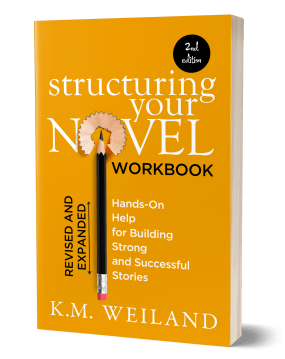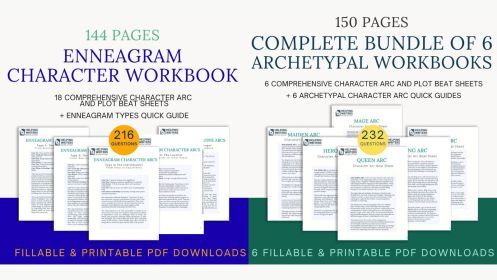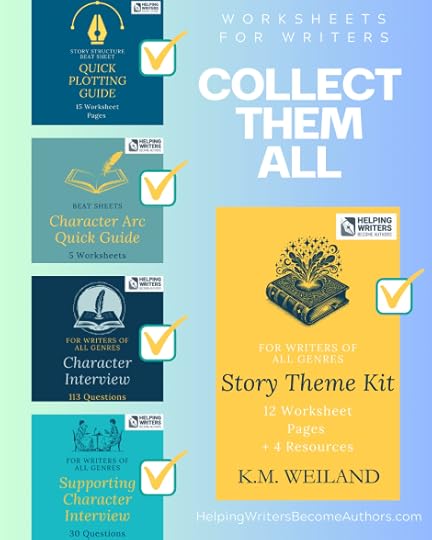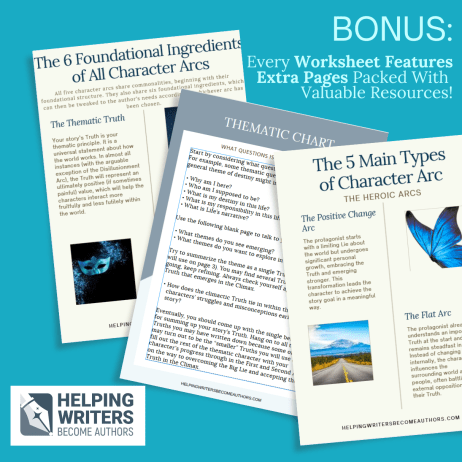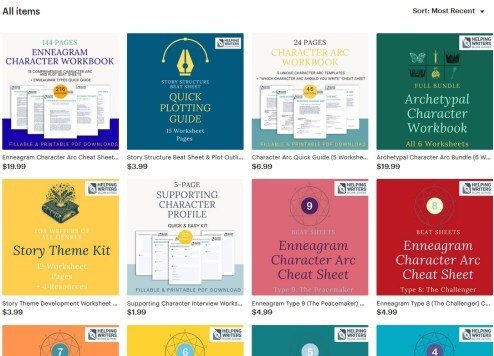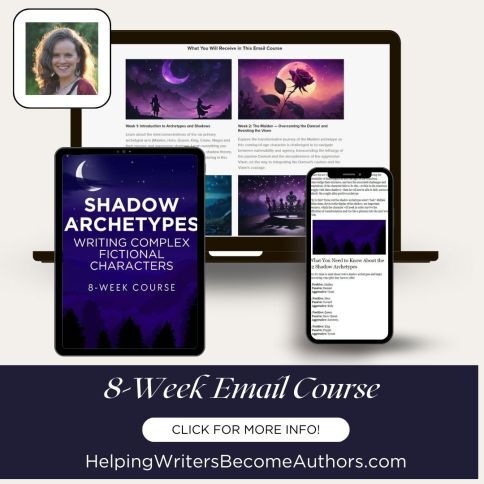K.M. Weiland's Blog
October 13, 2025
Structuring Your Novel Workbook: Second Edition Launch + Freewrite Wordrunner Giveaway
When I first wrote Structuring Your Novel over a decade ago, I didn’t know it would become one of my most beloved books—helping almost 100,000 writers find clarity and confidence in their storytelling. Hearing from writers who finished their manuscripts or published their books because of it has been one of the greatest joys of my career.
Last year, I released a revised and expanded second edition of Structuring Your Novel to celebrate its 10-year anniversary. I added new chapters, refined explanations, and updated the material with everything I’ve learned in the past decade about story structure. But I knew that wasn’t quite enough.
The workbook that accompanied the first edition needed an upgrade too! Writers have been asking me for years to expand it and make it even more practical and comprehensive. So I rolled up my sleeves and did just that.
This new second edition of the Structuring Your Novel Workbook is filled with 80 brand-new exercises, updated terminology, and refined guidance that matches the new edition of the main book. My goal was to create a hands-on tool that doesn’t just explain structure but helps you apply it—step by step—to your own stories.
So today, I’m thrilled to share the Revised & Expanded Second Edition of the Structuring Your Novel Workbook—a hands-on guide to help you apply story structure directly to your own projects.

Celebrate the release of K.M. Weiland’s Structuring Your Novel Workbook, Revised & Expanded Second Edition. Packed with new exercises and prompts, this hands-on guide helps writers master story structure and craft powerful novels.
Where Can You Buy the Workbook?You can purchase the Structuring Your Novel Workbook (Revised and Expanded 2nd Edition) at the following links:Amazon USA e-book (affiliate link)Amazon USA paperback (affiliate link)Amazon UKAmazon CanadaAmazon AustraliaAmazon JapanKoboBarnes & NobleApple BooksEpub Direct From My SiteAnd check out the special edition!Special Edition Fillable PDF Version (which means you can fill it out directly on your computer!)If you have already read the first edition, I would totally appreciate it, if you’d consider leaving a review on the new one! Creating a new edition meant losing the over six hundred reviews the book collected over the past decade. I would totally appreciate it if you’d help me rebuild the review section!
More About the Structuring Your Novel Workbook (Revised and Expanded 2nd Edition)Make Story Structure Your Superpower!
If you’ve ever felt stuck halfway through your draft—or realized something’s off after typing “The End”—you’re not alone. Structure is the secret weapon behind every unforgettable story.
In her acclaimed writing guide Structuring Your Novel, award-winning author K.M. Weiland laid out the blueprint for powerful, cohesive storytelling. Now, with this newly expanded 10-year anniversary edition of the Structuring Your Novel Workbook, it’s time to put plot structure to use in your own stories.
Packed with hundreds of insightful questions and creativity-sparking exercises—including 80 brand-new prompts and an in-depth chapter on the Inciting Event—this workbook will help you:
Build a rock-solid plot structurePerfectly time your plot points for maximum impactTurn structural weaknesses into storytelling strengthsPinpoint and fix a sagging middle with a powerful “centerpiece” sceneForeshadow key events with subtlety and skillAnd much more!Whether you’re plotting a new project or revising a rough draft, this hands-on guide will give you the tools to craft compelling stories—every time.
Every great novel starts with a strong foundation. Lay yours today.
Giveaway: Celebrate With Me!
Enter to win a Freewrite WordRunner (or Freewrite Alpha) in celebration of the launch of K.M. Weiland’s Structuring Your Novel Workbook, Revised & Expanded Second Edition. Giveaway open now – don’t miss your chance!
To mark this release, I want to celebrate with all of you. As a thank-you, I’m running a special giveaway!
One lucky winner will receive the brand-new Freewrite WordRunner keyboard—a sleek, mechanical writer’s dream that tracks word counts and helps you sprint distraction-free. (Because the WordRunner is currently on pre-order and will be shipping early next year, the winner can also choose to receive the Freewrite Alpha instead—a fantastic distraction-free writing device.)
Description of the Freewrite WordRunner:
The Freewrite Wordrunner is a futuristic, writer-first mechanical keyboard crafted for focus and productivity. Built on a durable die-cast aluminum chassis, it features an innovative “Wordometer” (a real-world, electromechanical word counter), a customizable sprint timer with LED indicators, and a refined function row with keys like Undo, Find, Paragraph Up/Down, plus three macro keys labeled Zap, Pow, Bam. Its red joystick controls media playback and volume, and you can pair it with up to four devices, wired or via Bluetooth. It’s sleek, writer-centric, and instantly distraction-proof.
To EnterWinners will be announced Monday, October 20th (via email and on Instagram). Enter below! (Note: no purchase is necessary to enter.)
If you’ve ever struggled with sagging middles, confusing plot points, or stories that don’t quite land, this workbook is designed to guide you through step by step. I hope it will help you build stronger stories, faster drafts, and more satisfying writing journeys.
Every great novel starts with a strong foundation. Lay yours today!
Wordplayers, tell me your opinions! What part of structuring your stories do you find most challenging—timing your plot points, building momentum through the middle, or tying everything together in the ending? Tell me in the comments!The post Structuring Your Novel Workbook: Second Edition Launch + Freewrite Wordrunner Giveaway appeared first on Helping Writers Become Authors.
September 29, 2025
Single vs. Multiple Narrators: Pros and Cons for Novelists
 Note from KMW: I’m taking a short break this week to hang out with my brand-new niece! While I’m off getting cuddles, here’s a quick post you can read in just a couple of minutes. No podcast today, just a bite-sized look at an important storytelling choice.
Note from KMW: I’m taking a short break this week to hang out with my brand-new niece! While I’m off getting cuddles, here’s a quick post you can read in just a couple of minutes. No podcast today, just a bite-sized look at an important storytelling choice.
One of the biggest questions novelists face is whether to use a single narrator or multiple narrators. Multiple POVs can broaden perspective and heighten tension, while a single POV offers intimacy and focus. Today, I’m breaking down the pros and cons of each approach and sharing my own surprising realization about the books I tend to love most.
And don’t forget! To help you dig even deeper into the building blocks of strong stories, you can now pre-order the e-book version of the revised and expanded second edition of the Structuring Your Novel Workbook on Amazon. (The paperback and a deluxe fillable PDF version will become available next week on the official launch day, October 6th—along with an epic giveaway. See you then!)
***
A lively debate among writers and readers often centers on the number of narrators in a novel. Should a story be told through a single narrator’s voice or unfold through the perspectives of multiple narrators? A few years ago, I hosted a discussion on Facebook and Twitter/X where most authors favored two or more narrators. Yet several readers argued their favorite books were those written from the perspective of just one character.
Today, let’s take a quick look at this question: what are the advantages and disadvantages of single-narrator vs. multiple-narrator novels?
The Benefits of Multiple NarratorsAt first glance, the benefits of multiple POV characters are obvious. Telling a story through several narrators allows us to give readers a broader perspective. Not only can we share first-hand accounts of different events, but we can also layer contrasting perspectives—such as when characters observe one another and offer commentary we wouldn’t get inside the head of any one character alone.
This approach can also increase tension and suspense, since readers often know more than the characters do. For example, one narrator may walk blindly into a trap that another narrator has already warned us about.
The Benefits of a Single Narrator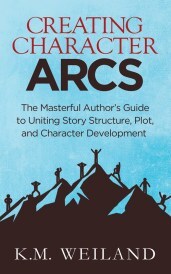
Creating Character Arcs (Amazon affiliate link)
The advantages of a single POV novel aren’t always as obvious, but they’re powerful. A one-narrator structure tightens the plot focus, prevents unnecessary rambling, and reduces extraneous subplots. More importantly, it provides space to deeply develop the protagonist’s character arc.
A single narrator also creates intimacy. Readers are invited to experience the story through one lens, fostering a strong bond with the main character. That said, the limitations are real: single POV books can feel narrow, and readers may become frustrated if they’re locked out of crucial events happening offstage.
Which POV Is Right for Your Novel?Ultimately, neither approach is wrong. Writers must analyze the needs of their story structure to decide which technique best serves it. Before making a decision, reflect on your own reading experiences.
For example, although I’ve used multiple POVs in all my novels, I realized most of my favorite books rely on the precision and intimacy of a single narrator (which was one of the reasons I decided to go with a single POV in my most recent novel Wayfarer).
That insight may help you decide which POV strategy best supports your story’s goals.
In SummaryYour choice of POV, whether single or multiple, will completely change the way your story unfolds. By weighing the pros and cons of each narration style, you’ll be better equipped to craft a novel that delivers the exact reading experience you want.
Key Takeaways:Multiple narrators broaden perspective, layer tension, and offer contrasting viewpoints.Single narrators tighten focus, streamline the plot, and strengthen the protagonist’s development.The “right” choice depends on the story you’re telling and the experience you want your readers to have.Wordplayers, tell me your opinions! Do you prefer reading (or writing) novels with a single narrator or multiple narrators? Why? Tell me in the comments!The post Single vs. Multiple Narrators: Pros and Cons for Novelists appeared first on Helping Writers Become Authors.
September 22, 2025
Big vs. Small Character Arcs: Understanding the Degrees of Change in Storytelling
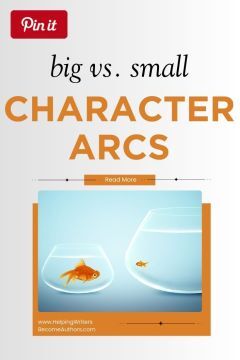 Not every story needs a protagonist who undergoes a sweeping, life-altering transformation. Many memorable tales hinge on smaller, quieter shifts in perspective—or even on characters who stay true to themselves from beginning to end. Writers often hear that character arcs must be dramatic to be meaningful, but the truth is arcs exist on a spectrum. Big character arcs can redefine a protagonist’s entire worldview, while small character arcs can reveal subtle but powerful growth that shapes the story in more understated ways. Understanding when to use a big arc, a small arc, or even a Flat Arc can help you choose the right level of change for your characters and keep readers invested from page one.
Not every story needs a protagonist who undergoes a sweeping, life-altering transformation. Many memorable tales hinge on smaller, quieter shifts in perspective—or even on characters who stay true to themselves from beginning to end. Writers often hear that character arcs must be dramatic to be meaningful, but the truth is arcs exist on a spectrum. Big character arcs can redefine a protagonist’s entire worldview, while small character arcs can reveal subtle but powerful growth that shapes the story in more understated ways. Understanding when to use a big arc, a small arc, or even a Flat Arc can help you choose the right level of change for your characters and keep readers invested from page one.
When I write about character arcs, I use sweeping terms about overcoming the Lie the Character Believes in pursuit of the thematic Truth. We talk about your character encountering Doorways of No Return, Moments of Truth, and Dark Nights of the Soul. All of these terms sound epic because they are symbolic. This means they can be applied in different stories to varying degrees of intensity. Just as in our own lives, some character arcs will rock the very foundations of the earth, while others may only offer a comparatively tiny realignment of perspective (perhaps as a building block toward one of those earth-shattering changes later on, but perhaps not too).
A while back, Tom Dell’Aringa emailed me with the following observation and query:
I’ve been following your stuff for a while. I was watching one of your videos on beginnings because I write a series, where the main character and his sidekick don’t change (like Jack Reacher or Jack Ryan, etc., although SF). While I always try to have some issue the main character is working through, he can’t go through some amazing transformation each book. Part of the joy of a series is sticking with a character you like, with all their pros/cons…. I wonder if you had thoughts on how to approach a series while living into the structure you have set out….
First of all, it’s important to recognize not every story will feature a Change Arc. Particularly in series, many characters demonstrate Flat Arc characteristics in each episode. This allows the story’s primary structures to remain unchanging, which allows steadfast characters to represent the story’s Truth to other characters—and therefore to be the one who prompts change rather than the one who changes. (If you’d like a hands-on tool for identifying and planning these different types of arcs, take a look at my Character Arc Worksheets.)

Character Arc Quick Guide (Bundle of 5 Worksheets)
It’s also possible to write stories that really don’t present much of an arc at all, although this is trickier since if the characters do not change, then it is difficult to create any true sense of movement or meaning within the plot itself. Most of the time, if you really look for it, even in tricky stories, you can still identify the underlying symbolic landmarks of some kind of arc, either in the protagonist or the supporting characters.
With all of that in mind, it’s important to remember you can feature a Change Arc without it necessarily having to offer tremendous transformation. When we speak of a Change Arc (whether Positive or Negative), we are simply referring to the fact that the character changes perspective in some way. Sometimes this can be a life-changing paradigm shift, but sometimes the change can be quite small (although it must still be consequential to the story). Particularly in plot-forward stories, the thematic Truth a character learns might even be something practical about the plot mechanics (e.g,. whodunit) rather than a deep personal or social insight. (For my money, however, stories are easily upleveled when the two go hand in hand.)
In short, character arcs in different stories won’t all look alike or carry the same weight. From here, we’ll break down the difference between big arcs, small arcs, and Flat Arcs, and explore how you can choose the right degree of change to best serve your story.
In This Article:Big Character Arcs and How Transformation Redefines the ProtagonistSmall Character Arcs and How Quiet Shifts Can Still Grip AudiencesFlat Arcs and How Characters Stay True While Still Driving the PlotBig Character Arcs and How Transformation Redefines the ProtagonistWhen we think of “thematic” stories, they are usually ones in which the character arcs are so big they completely redefine the characters’ worldviews and perhaps even the world itself. Like all character arcs, these changes are founded upon the central polarity between a Lie the Character Believes and the opposing Truth. At its simplest, this Lie is a limited perspective, while the Truth acts as a corrective by providing at least a slightly more expanded and functional advancement on that perspective.
In big Change Arcs, this conflict between Lie and Truth tends to be dramatic. This raises the stakes because the transition into the new perspective will all but demolish the character’s previous perspective. This inevitably involves a personal ego death and a transformation of personal identity (i.e., how characters view themselves). Likely, it will also play out in dramatic fashion in the external plot. Characters will have much to gain or much to lose depending on which perspective they end up embracing.
For Example:
A clear example of a dramatic Positive Change Arc can be seen in Schindler’s List. At the beginning, Oskar Schindler believes the Lie that his worth and power come from wealth, status, and self-interest. His identity is bound up in being a profiteer who exploits the war for personal gain. Over the course of the story, he is confronted with the Truth that real value lies in human life and moral responsibility.
Embracing this Truth demolishes his former worldview and forces him through a profound ego death, reshaping how he sees himself and his place in the world. Importantly, this transformation is not just personally dramatic: it also plays out against the larger system of Nazi Germany, where Schindler’s new Truth is in direct conflict with a regime fighting to assert its own destructive “truth” as socially preeminent. His decision to resist this system is not only perilous to him personally, it also highlights how a big Change Arc reverberates outward. The character’s internal shift becomes a force of external opposition in a dangerous world, raising both personal and thematic stakes to their highest pitch.

Oskar Schindler’s transformation in Schindler’s List is a powerful example of a big character arc. (Schindler’s List (1993), Universal Pictures.)
These dramatic personal and social stakes are true whether the character ends up in a Positive Arc from Lie to Truth or in a Negative Arc from Truth to Lie.
For Example:
The Banshees of Inisherin shows a powerful example of how a Negative Change Arc demolishes identity and spirals outward into destruction. At the start, both Pádraic and Colm have perspectives that, while limited, still allow for human connection: Pádraic clings to the Lie that being “nice” and “happy” will guarantee him love and belonging, while Colm seeks significance by isolating himself to pursue art, believing the Lie that human relationships are expendable in the quest for legacy.
As the story progresses, each man is drawn deeper into his respective Lie. Pádraic’s desperation to hold on to friendship corrodes his innocence, while Colm’s rejection of the relationship becomes increasingly violent and self-mutilating. These internal disintegrations don’t remain private. Just as in big Positive Arcs, in which the Truth collides with the larger world, here the embrace of the Lie clashes with the community, escalating conflict and despair. By the end, both characters have been transformed by the loss of whatever humanity and hope they once held. Their Negative Arcs show how a shift from Truth to Lie can unravel not only personal identity but also the fragile social bonds of an entire world.

In The Banshees of Inisherin, Colm and Pádraic’s relationship shows how Negative Change Arcs can unravel both identity and community. The (Banshees of Inisherin (2022), Searchlight Pictures.)
Small Character Arcs and How Quiet Shifts Can Still Grip AudiencesMany stories feature smaller character arcs with lower stakes. In these stories, the Lie/Truth will be less obviously mind-bending and ego-threatening. The thematic premise might span the gamut from “learning a moral lesson” (e.g., “be more loving”) to simply “seeing something in a new light” (e.g., “maybe my life is more interesting than I thought”) to even just “learning a practical lesson” (e.g., “mad scientists shouldn’t play god” or “the dangerous monster can be defeated if we work together” or even “karate makes me powerful”).
In smaller arcs, characters will not necessarily need to experience a dramatic ego death or shift in personal paradigm or identity. They may end the story simply feeling slightly more whole or affirmed. Bigger arcs tend to speak more obviously to our deeper psyches and to the audience’s own inner experience of symbolic life. This is because their scope allows them to draw down bigger and more powerful symbolism, since they often deal with high-stakes situations that are relatively rare in day-to-day life, allowing them to offer important cathartic experiences.
Meanwhile, smaller arcs can be extremely satisfying for audiences in their ability to recreate the sort of relatable situations we all regularly encounter and work through. Major ego deaths are threshold experiences that only happen a few times throughout our lives; smaller perspective shifts, however, happen on a daily basis. The best small arcs are those that intentionally lean into the verisimilitude and reliability of daily evolution.
For Example:
The show Gilmore Girls thrives on micro arcs that bring satisfying movement to each episode without fundamentally altering the characters. Mother and daughter protagonists Lorelai and Rory are defined by strong personalities and consistent worldviews, and the series’ charm lies in watching those traits play out in different circumstances. Most episodes introduce a conflict rooted in family dynamics, town politics, or personal relationships, such as Lorelai needing to smooth things over with her parents or Rory stumbling in balancing academics with friendships. By the end of the episode, the tension is usually resolved with a small shift in outlook: someone apologizes, admits fault, or simply sees a situation from a slightly different angle.
These micro arcs don’t reinvent the characters. Lorelai doesn’t stop being witty and independent, Rory doesn’t stop being studious, their mother/grandmother Emily doesn’t stop being controlling. But the little tweaks in understanding provide the story’s sense of movement while keeping the characters familiar and dependable, which is exactly what makes viewers want to return to the town of Stars Hollow week after week.
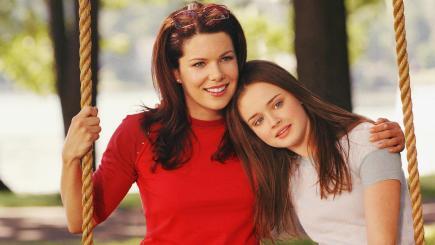
In Gilmore Girls, Lorelai and Rory show how small character arcs—tiny shifts in perspective or relationships—can carry a story’s emotional heart. (Gilmore Girls (2000-2007), The CW.)

Writing Your Story’s Theme (Amazon affiliate link)
Often, however, small arcs are less advantageous in bigger stories. In neglecting to pair meaty character arcs with the high stakes of plot-driven spectacles, stories often gut their very soul—theme. Theme arises directly from the interplay of external events challenging characters to change—not just on an external, practical level, but on a deep, personal level. When episodic high-tension stories fail to match their plot events with commensurate character evolution, they are not only missing out on their best potential, but also presenting an ultimately dissatisfyingly out-of-sync presentation of reality. They often ring hollow and become all-too-forgettable for the simple reason that their bluff and bluster isn’t allowed to mean anything.
For Example:
Jurassic World: Fallen Kingdom heightened its spectacle even further than its predecessors, escalating the stakes to include not just an island of dinosaurs but the potential weaponization and global spread of these creatures. Yet despite the apocalyptic implications, the characters’ arcs remain small and underdeveloped. Claire softens slightly from her corporate-minded pragmatism into a more openly compassionate activist, but this shift is incremental compared to the world-shattering events around her. Owen, meanwhile, remains essentially unchanged—an action hero stereotype who doesn’t evolve in any significant way.
The mismatch between the immense external conflict and the modest internal growth means the film struggles to generate any thematic depth whatsoever. Its bluff and bluster never quite land because the story neglects the deeper resonance that comes when characters’ internal journeys rise to meet extraordinary stakes.
By contrast, the original Jurassic Park paired its high-stakes dinosaur spectacle with a heartfelt internal arc: Alan Grant’s begrudging discomfort with children gradually transforms into protectiveness and affection as the high stakes demand he bond with the two children in his care, giving the story an emotional anchor that elevates its thrills into resonance.
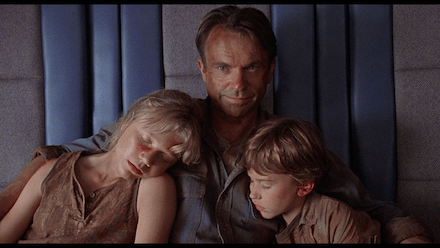
Alan Grant’s quiet transformation in Jurassic Park shows how small arcs can give big stories their emotional heart. (Jurassic Park (1993), Universal Pictures.)
Flat Arcs and How Characters Stay True While Driving the StoryA final consideration for your story is the Flat Arc. The Flat Arc represents, basically, the next level a character may reach after a Change Arc. The Flat Arc is a story about a character who already “gets” the Truth. However, because stories still require the engine of internal change in order to generate meaning, these stories will still feature characters who change. The difference is that here, the Flat Arc protagonist acts as an Impact Character who represents the thematic Truth and inspires Change Arcs in the supporting characters—whether those arcs are large or small.
So much can be done with a Flat Arc character. Not only can they be used to create a stable axis for an ongoing series, in which potentially everything changes except the protagonist—they can also develop tremendous complexities in their own right. The most important thing to remember about Flat Arc characters is that just because they’ve figured out the thematic Truth at the center of the story, this doesn’t mean they understand all truths—or even any other truth. In short, they can be wonderfully limited and flawed characters while still acting as catalysts for the changes that need to happen in the external story world.
For Example:
Sherlock Holmes remains firmly grounded in the series’ central Truth that rational observation and logic can uncover reality. He doesn’t need to undergo a sweeping personal transformation from story to story; instead, he acts as the stable axis around which the mystery turns. This doesn’t mean Holmes is perfect or even well-balanced. His arrogance, addiction, and emotional blind spots remind us that a Flat Arc character can be deeply limited.
What makes him fascinating is precisely this tension: he embodies the thematic Truth that reason exposes deception, but he does not grasp (or refuses to engage with) many other truths, such as those of empathy, humility, or human connection. His steadfastness allows him to be a catalyst for the story’s external resolution, while his flaws keep him vivid and complex, preventing him from collapsing into a lifeless stereotype.
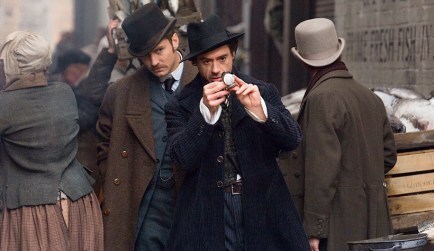
Sherlock Holmes demonstrates a Flat Arc: he already embodies the thematic Truth of reason and logic, shaping the story world without undergoing major change himself. (Sherlock Holmes (2009), Warner Bros.)
This makes Flat Arc characters excellent choices for many types of series, especially episodic series, in which the central premise remains the same (e.g., a detective solving a mystery) while the plot details change (e.g., new murderer and new suspects in each installment). Flat Arc characters tend to be particularly archetypal. In their unchangingness, they represent a single symbolic catalyst. While this can create striking depth, it can also become stereotypical and, yes, flat very quickly.
Used with discretion and awareness, Flat Arc characters stand as extremely powerful and inspirational (or cautionary) figures. Fundamentally, they represent characters who are a step ahead on the path. They are characters who have emerged from the comparative ignorance of a previous Positive Change Arc (even if it is never referenced) in order to embody a particular Truth (i.e., a slightly more expanded perspective than that of the surrounding story world). Their seeming simplicity can actually make them quite tricky to write well, but when executed skillfully, they provide all kinds of versatility for the author.
For Example:
Atticus Finch in To Kill a Mockingbird is a quintessential example of a Flat Arc character used with tremendous discretion and power. He has already moved beyond the ignorance of believing society’s Lie—that prejudice and inequality are acceptable—and now lives firmly in the Truth of justice, empathy, and human dignity. Because he stands a step ahead of the rest of Maycomb, his role is not to transform internally but to act as a moral catalyst, challenging the community and inspiring his daughter Scout.
His apparent simplicity (i.e., he is calm, principled, unwavering) makes him seem almost mythological, which is precisely what gives him his symbolic force. He embodies a Truth others must grapple with, and the drama arises from how his world reacts to his steadfastness rather than from any change within him. Written well, such Flat Arc characters can serve as luminous figures, offering readers a vision of what it looks like to live by a deeper Truth even when it comes at great personal cost.
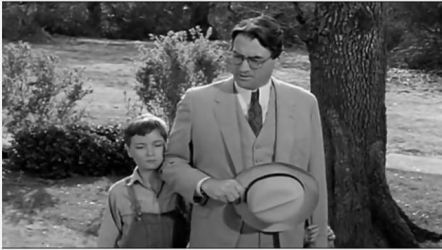
Atticus Finch shows how Flat Arc characters embody moral truth and inspire growth in others without needing to transform themselves. (To Kill a Mockingbird (1962), Universal Pictures.)
Whether you’re writing a sweeping epic or a cozy slice-of-life, remember: the heartbeat of your story lives in the character arcs. Big arcs grip us because they reflect the rare, seismic changes of real life, while small arcs and Flat Arcs resonate because they reflect the daily steps of growth, resistance, and steadfastness we all experience day to day. When writers understand the spectrum of arcs available to them, they gain the power to craft stories that feel meaningful and true while also choosing the approach that makes the most sense for any particular story.
In SummaryCharacter arcs exist on a spectrum—from dramatic transformations that shatter identity to small but satisfying shifts in perspective,to Flat Arcs that anchor the story’s thematic Truth. Each option brings different opportunities and challenges, and the best choice depends on the kind of story you’re telling.
Key TakeawaysBig Arcs: Redefine a character’s worldview through dramatic conflict between Lie and Truth.Small Arcs: Mirror everyday perspective shifts that create relatability and subtle growth.Flat Arcs: Provide a stable axis through embodied experience that inspires change in others.Balance matters: The scale of the arc should align with the scale of the story’s stakes to create resonance and theme.Want More?Need a fast, reliable roadmap for mapping out your characters’ journeys?
Check out my Character Arc Quick Guide Pack, featuring five fillable worksheets that break down the essential beats of every major arc type (Positive, Flat, Disillusionment, Fall, and Corruption). Whether you’re outlining a brand-new protagonist, testing alternate possibilities for a supporting cast, or just looking for a quick-reference checklist during revisions, I designed these worksheets to give you a streamlined way to develop arcs that work. Instantly downloadable, printable, and reusable, they’re designed to save you time while making sure your characters’ inner journeys stay just as compelling as your plot twists.  Grab the Character Arc Quick Guide Worksheets here.
Grab the Character Arc Quick Guide Worksheets here.

Plan your story with the Character Arc Workbook Quick Guide—5 templates, 45 questions, and a cheat sheet to help you choose the right arc.
Wordplayers, tell me your opinions! What kind of character arcs do you most enjoy writing—or reading? Do you prefer the catharsis of big transformations, the relatability of small shifts, or the steadfast power of Flat Arcs? Tell me in the comments!Click the “Play” button to Listen to Audio Version (or subscribe to the Helping Writers Become Authors podcast in Apple Podcast, Amazon Music, or Spotify).
___
Love Helping Writers Become Authors? You can now become a patron. (Huge thanks to those of you who are already part of my Patreon family!)The post Big vs. Small Character Arcs: Understanding the Degrees of Change in Storytelling appeared first on Helping Writers Become Authors.
September 15, 2025
How a Character’s Personality Shapes Arc, Voice, and Goals
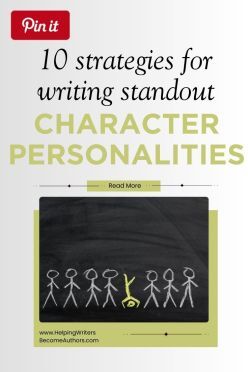 When it comes to creating memorable, emotionally resonant characters, your character’s personality may seem like it’s just a “flavor,” but in many ways it’s actually the foundation of the story itself. Your character’s personality influences everything: the character arc, the voice in both dialogue and the narrative (if the character has a POV), and the goals that shape your entire plot.
When it comes to creating memorable, emotionally resonant characters, your character’s personality may seem like it’s just a “flavor,” but in many ways it’s actually the foundation of the story itself. Your character’s personality influences everything: the character arc, the voice in both dialogue and the narrative (if the character has a POV), and the goals that shape your entire plot.
In many ways, your characters’ personalities can determine whether or not the story works. This is most obviously true when it comes that special “it” factor that creates unforgettably quirky or nuanced characters, but it’s even more true when it comes to the cohesion of your story’s deeper workings—where character, plot, and theme all come together.
In short, understanding personality might just be one of the most powerful tools in a writer’s toolbox.
In This Article:3 Reasons Why Personality Is the Secret Ingredient to Strong Characters4 Ways a Character’s Personality Drives Your Storytelling10 Practical Tips for Weaving Personality Into Character Arc, Plot, Dialogue, and MoreFAQs About Character Personality3 Reasons Why Personality Is the Secret Ingredient to Strong CharactersThe concept of personality brings a number of different connotations.
1. Personality Is a Consistent Set of TraitsFor starters, we recognize the technical definition of personality as a consistent set of traits, behaviors, emotional patterns, and motivations that shape how someone perceives the world, makes decisions, and interacts with others. Personality influences not just what people do, but why they do it, how they react under pressure, form relationships, pursue goals, and confront internal or external conflict.
2. Personality Is CharismaThere is also a certain sense of je ne sais quoi—that special sauce that makes an individual unique and interesting. When the word “personality” is brought up in a fictional context, we generally tend to think of characters with big, interesting (read: complex), and memorable personalities. They’re not beige; they’re intriguing in their relatability but also because of their unique ways of viewing and responding to the world.
3. Personality Is the Ego or False SelfHowever, personality can also be understood as the “false” or “egoic self”—a persona honed throughout our lives to allow us to move functionally through society and relationships, but which is ultimately limiting to the bigness of our true selves.
Writers can make good use of all three of these definitions. Thinking intentionally about a character’s personality allows us to craft a container in which we can sift through potential traits, reactions, and goals to find those that offer the most cohesion for the entire story. From there, we can explore ways to create characters with inherently entertaining or intriguing personalities—ones with the potential to join iconic classics such as Michael Corleone, Jo March, Tony Stark, Sarah Connor, Gandalf the Gray, and Hermione Granger (their names are as famous, if not more, than the stories they play in).





 4 Ways Personality Drives Storytelling
4 Ways Personality Drives StorytellingMost of the time, when writers consider a character’s personality, they focus primarily on outward traits. However, in so many ways, a character’s personality is the story. Here are four key considerations.
1. Personality Shapes the Character Arc
Although some personality systems offer static descriptions of traits, others like the Enneagram go deeper to point out specific transformational paths that can help people break past the ego-based facades and personas that limit us and create dysfunction. From this perspective, personality is all about the character arc!
Although most personality systems worth their salt (including MBTI, Human Design, Socionics, love languages, attachment styles, even astrology, and more) ultimately offer pathways of growth, the Enneagram is somewhat unique in its focus on specific paths of evolution (or devolution as the case may be) for each type. As I’ve explored before, this makes the Enneagram perhaps the most useful personality system for not just identifying and fleshing out a character’s personality, but for using that personality to create a cohesive character arc and, from that, plot and theme as well.
If you’d like more guidance, I’ve talked here about the Positive Change Arcs inherent in each of the nine Enneagram types and here about the Negative Change Arcs inherent in each type. I’ve also just released a full set of worksheets for each of the nine types. Each bundle includes questions to guide you in planning either a Positive or Negative Arc for each of the types, which will help you ensure your character’s arc, Lie vs. Truth, and Want vs. Need are aligned with the character’s personality, while also helping you brainstorm ways to make your character’s personalized arc consistent with the overall plot and theme.

Enneagram Character Arc Cheat Sheet Bundle – Square for Etsy
2. Personality Informs Voice and DialoguePerhaps nothing in your story is more obviously influenced by personality than character voice. When we think of personality on the page, we think about voice more than anything else. How a character communicates—whether in dialogue or directly through the narrative in a tight POV—directly communicates personality. In my own experience, I’ve found that if my narrative is struggling, it’s often because I’m trying to write in the POV of a character whose voice just doesn’t have enough personality.
Personality will also directly influence your character’s dialogue style. This isn’t just about word choice. It’s also about the character’s preferred “style” of arguing or engaging in conflict. For example, a more aggressive personality type like an Enneagram 8 or an MBTI ENTJ will have an entirely different style of attack and defense (aka, initiating desires or responding to others’ desires) than will an Enneagram 9 or a Human Design Reflector.
Writing is all about the words, and nothing influences word choice, tone, emotional reactions, dialogue style, conflict resolution, or argument styles more than personality.
(You can find questions to help you uncover all of this is another of my hot-off-the-presses worksheets—the Character Interview, featuring 113 questions, many of them about personality.)
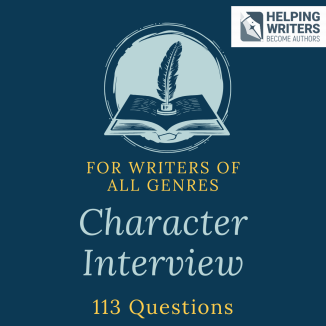
Character Interview Digital Worksheet for Writers
3. Personality Determines Shadow and Subconscious Goals“Personality” literally refers to what we see on the surface, and yet personality is formed by what is unseen—by what has been banished to the “shadow” or the unconscious. What we see in a personality is really just what’s left after certain traits, energies, beliefs, and identities have been deemed dysfunctional (usually unconsciously early in childhood) and “cut off” from the conscious personality.
This is important for storytellers because uncovering your character’s shadow will likely be an intrinsic part of the character arc. Character arc, at its simplest, is about expanding a limited perspective. Ultimately, this perspective is always about one’s self. Even if it seems to be a change in perspective regarding others or the world at large, ultimately this new “Truth” reflects upon the self’s place in relationship to others. This means the “limited perspective” (or Lie the Character Believes) is a product of the necessarily always limited personality, while the “expanded perspective” (or thematic Truth) is, at least in part, a restoration of some piece of the self previously lost to the shadow.
From here, we can see how character goals are almost always driven by this deeper subconscious motivation. A character’s personality isn’t just traits. More deeply, personality is what the character fears, represses, and unconsciously chases. Right there, you already have an entire story!
4. Personality Reveals Core Strengths and WeaknessesOnce we recognize personality as not just someone’s (presumably functional) persona, we can see the deeper truth that personality is, in fact, as much about inherent weaknesses as inherent strengths. Understanding this about your character’s personality gives you a fast track to the central internal conflict.
Stories run on the tension points between polarities—between strengths and weaknesses, between Lies and Truths, between delusions and epiphanies, between cowardice and courage, between mistakes and successes. All of these are inherent to your character’s personality. What is a stressful internal dissonance for one personality (e.g., balancing an Enneagram Five’s need for connection against the fear of overwhelm) is already a natural integration for another type (such as a Two, who struggles with different tension points).
A firm understanding of a useful personality type system can help you double-check your character’s development arcs for consistency and realism. When you’re in the early throes of writing, it can be easy to scribble things onto the page that, in the big view, don’t actually create the necessary and realistic tension points that arise from a consistent portrayal of human nature. An understanding of personality can guide you to which arcs are most natural to your characters.
10 Practical Tips for Weaving Personality Into Plot, Dialogue, and ArcAll right, enough theory! Let’s get practical. How can you use personality more intentionally to develop not just a better character, but a more cohesive and resonant plot and theme as well?
Let Personality Shape the Story1. Choose a Personality Framework Early in Your Planning Process— Use a system like the Enneagram or MBTI to explore internal motivations and potential arcs.
— I recommend focusing on one primary personality system to avoid overcomplication.
— Once you know your character’s personality, examine the system as a guide to help you find the most resonant growth path.
2. Use Personality to Predict Conflict Style— Start working on your plot by considering what conflict style (e.g., competing, avoiding, collaborating, etc.) best fits your character’s personality.
— Think about how your character argues, avoids, or escalates conflict based on type.
— This adds nuance to both dialogue and plot tension, while showing you what types of scenes are most likely to emerge when your character’s goals are met with obstacles (i.e., conflict).
— Your character’s conflict style is one of the richest places to mine for entertainment opportunities.
— For example, consider Han Solo’s classically sarcastic but often off-point retorts: “We’re all fine here now… how are you?”
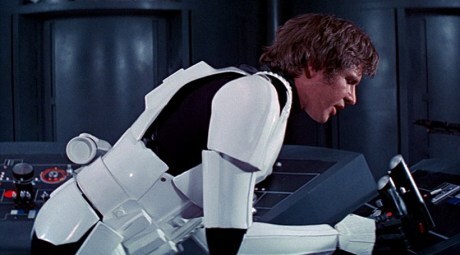
Star Wars: A New Hope (1977), 20th Century Fox.
–Ask: How can your character’s conflict style create dynamic, unusual, or larger-than-life scenes?
3. Let the Shadow Reveal the Theme
Writing Your Story’s Theme (Amazon affiliate link)
— Use the subconscious fear or flaw inherent in your character’s personality to point toward the story’s deeper thematic question.
— For example, a character with an avoidant attachment style might prompt thematic explorations of self-isolation or self-sabolage, such as Elsa in Frozen.
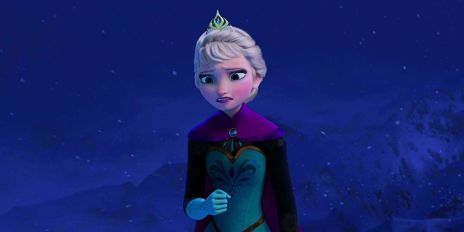
Frozen (2013), Walt Disney Pictures.
— If you’re unsure what might be in your character’s personality shadow, remember shadow theory’s simple guideline: “Whatever is visible in a person’s external personality is an indication that the exact opposite resides in the shadow.”
— For example, an MBTI INTP character—who relies most heavily on mental functions—may resonantly create a story about exploring the underworld of grief or the bewilderment of falling in love, such as R in Warm Bodies.
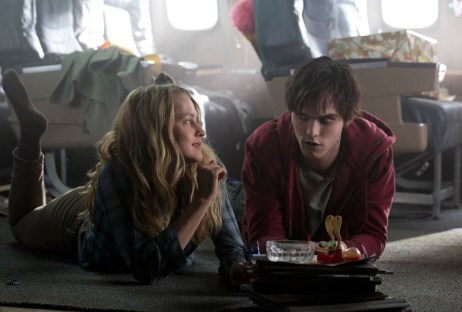
Warm Bodies (2013), Lionsgate.
4. Design Key Plot Beats Around Transformation Points
Personality Types by Don Richard Riso and Russ Hudson (affiliate link)
— Personality systems like the Enneagram particularly lend themselves to narrative arcs, since they suggest specific steps on a path to growth (in addition to my worksheets, you can check out Personality Types by Russ Hudson and Don Richard Riso for in-depth studies on this).
— For example, if you know your Enneagram Type Three character’s Lie is “I’m only worthy if I succeed,” you can shape the Midpoint or Third Plot Point to directly challenge that belief.
Let Story Reveal Personality5. Reverse-Engineer Personality From Your Plot— If your story idea came to you as a plot instead of a character, you can use what you know about the story’s external events to create the most resonant personality for your character.
— Ask: Based on the choices the plot indicates the character will need to make, what traits or fears will be likely to emerge in the character arc?
— From there, you can identify the most resonant personality type. +However, be sure to use the story events to discover (not dictate) who the character is.
— Character and plot should influence each other, but character should be the more dynamic force. This is to ensure that the plot feels organic and natural rather than contrived.
6. Analyze Plot Points to Discover Your Character’s Internal Values— Take a look at what your character sacrifices or clings to when the stakes are high. That alone can reveal your character’s personality type or predominant internal struggle.
— For example, as an Enneagram One, Jane Eyre always returns to the central question of right and wrong (as she sees it). When confronted by Rochester’s pre-existing marriage at the Third Plot Point, she decides to leave him less because she feels betrayed and more because she believes it would be morally wrong for her to illegally marry him.
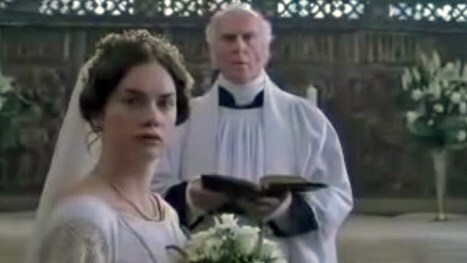
Jane Eyre (2006), WGBH/BBC.
7. Refine Your Character’s Type After Writing the First Draft— Sometimes, you won’t really know who your character is until after you’ve written the story.
— After finishing the first draft, you can go back to revise voice and dialogue to more clearly reflect a unified personality for your character.
Bonus Implementation Tips8. Create a Quick-Reference “Personality Snapshot”— Character personality—like most things in storytelling—can get complicated fast. Not only can relying on a personality system provide shortcuts to identifying and remembering character traits, but so can keeping a sort of “personality outline.”
— You can include your character’s personality type, dominant traits, shadow fear, core desire, communication style, and more.
— When writing, I always try to review at least a small portion of my notes every day before I begin to keep them fresh in my mind.
9. Use a Worksheet or Interview to Stress-Test Alignment— Although beat sheets and character interviews should only be used to create a flexible guide, they can be helpful for nailing down the big picture of your character’s personality and arc.
— You can find the free version of my character interview here, and you can grab the updated fillable pdf of the worksheet here.

Character Interview Digital Worksheet for Writers
— If you’ve chosen to use the Enneagram as your primary personality typing system, you may also find some help in my brand new Enneagram Character Arc Cheat Sheets to check whether the story beats align with the character’s internal journey. (Each bundle contains both Positive and Negative Change Arcs for each type.)

Enneagram Character Arc Cheat Sheet Full Bundle
10. Treat Personality as Dynamic, Not Fixed— I’m a big fan of the aphorism (usually attributed to George Box),
All models are wrong, but some are useful.
— This is true of so much in storytelling, and it is certainly true when it comes to personality systems.
— Although incredibly useful in helping writers distil the eminently complex topic that is the human personality, systems such as the Enneagram, MBTI, and more, are ultimately still limited and should only be used insofar as they are useful.
— Growth (or regression) in your character’s arc should always reflect believable changes in personality expression, and you should always listen to your own deep and instinctive understanding of the human ego, shadow, and persona above and beyond any fixed model.
Why Knowing Personality Unlocks Your Whole StoryYour character’s personalities aren’t just one layer of who they are. Personality is the central lens through which characters interpret the world, make decisions, and pursue goals. Personality is also the bridge between plot, theme, and character. Or perhaps we might think of it as the container that holds all three.
Personality shapes not only what your characters want, but why they want it, what’s standing in their way, and how they express that tension through action, voice, and internal conflict. That’s everything you need for your plot right there. When you understand your character’s personality, you gain access to the deeper psychological and thematic forces driving your story forward.
It’s important to remember there is no one “right” framework to use. Whether you gravitate toward the Enneagram, MBTI, Human Design, or something else, the most important step is simply choosing a system that resonates with you and then using it to stress-test your characters and their arcs.
FAQs About Character PersonalityWhat is the best personality system for writers to use?There’s no single best system, since each offers a different perspective. For instance, the Enneagram is ideal for exploring inner conflict and transformation, while MBTI is great for understanding cognitive wiring and behavior. The only thing that matters is choosing one that complements your writing style.
Can a character’s personality change throughout the story?Characters won’t change to a different personality, but how they relate from within the containers of their current personalities can dramatically evolve. A well-crafted character arc doesn’t usually change the core personality, but does change how the character expresses it. For example, withdrawn characters might learn to stay connected under pressure, without losing their introspective natures.
How does the Enneagram help with writing character arcs?The Enneagram maps core fears, desires, and defense mechanisms—all of which tie neatly into a character’s Lie, Want, Need, and Truth. Each Enneagram type also suggests likely growth paths and shadow pitfalls, which makes the system especially useful for writers when building Positive and Negative Change Arcs.
How do I figure out my character’s personality type?You can start by asking what your characters fear most, how they handle conflict, and what motivates their choices. Consider how they act under stress and in growth. Then compare those traits to personality types in your chosen system and adjust based on what best supports the arc you want to tell.
Want More?If you’re ready to dive deeper into using personality to guide your character arcs, check out my Enneagram Character Arc Cheat Sheets. Each worksheet bundle walks you through both Positive and Negative Change Arcs for all nine Enneagram types to help you align your character’s internal journey with your story’s external plot beats. You can use these digital worksheets when you’re outlining or revising to create arcs that are psychologically authentic and thematically resonant. Available now in my Etsy shop or via the Store tab above!

Enneagram Character Arc Worksheets
Wordplayers, tell me your opinions! What role does personality play in how you approach your characters? Do you start with a personality type, or does it emerge from the story? Do you use a system like the Enneagram or MBTI in your process? Tell me in the comments!Click the “Play” button to Listen to Audio Version (or subscribe to the Helping Writers Become Authors podcast in Apple Podcast, Amazon Music, or Spotify).
___
Love Helping Writers Become Authors? You can now become a patron. (Huge thanks to those of you who are already part of my Patreon family!)The post How a Character’s Personality Shapes Arc, Voice, and Goals appeared first on Helping Writers Become Authors.
September 8, 2025
Why All Stories Are Myth—and How They Transform Us
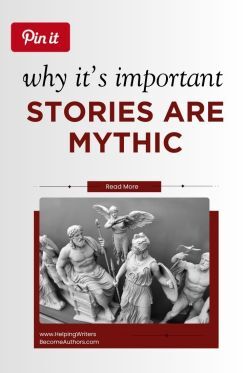 Stories are more than just entertainment. They’re also more than just reflections of real life. This is because, at its core, narrative is myth. Whether you’re crafting epic fantasy, gritty crime drama, or cozy rom-coms, deep archetypal patterns always echo through your characters, plots, and themes. Story is the theater of the psyche. It is a dream we collectively dream, in which each character and conflict embodies a part of ourselves. When we recognize this hidden foundation, we can tap this archetypal power to access the kind of storytelling that not only captivates readers but also transforms both their inner lives and our own.
Stories are more than just entertainment. They’re also more than just reflections of real life. This is because, at its core, narrative is myth. Whether you’re crafting epic fantasy, gritty crime drama, or cozy rom-coms, deep archetypal patterns always echo through your characters, plots, and themes. Story is the theater of the psyche. It is a dream we collectively dream, in which each character and conflict embodies a part of ourselves. When we recognize this hidden foundation, we can tap this archetypal power to access the kind of storytelling that not only captivates readers but also transforms both their inner lives and our own.
A few weeks ago, I shared a post that struck a chord with many of you—about my deep desire to witness the return of “soulful storytelling.” Specifically, I wrote about my personal dissatisfaction and even boredom with contemporary filmmaking. In that post, I talked about wanting to return to stories of subtextual depth, emotional earnestness, and goodheartedness (among other qualities). In pondering on this further via the many thoughtful exchanges I got to have with all of you in the comments section on that post, I realized there are more layers to the shifts we have seen in modern storytelling—and the next shift I believe we will soon see.
One of those layers is the tension we often feel, but perhaps do not always recognize, between hyper-realism in fiction and storytelling’s inherently mythic foundation. I’m talking about the differences between stories that dutifully mimic or even exaggerate the causality of everyday life and those that draw upon the timeless archetypal patterns of the psyche.
When asked to define “story,” we may reach for the convenient answer that story is a replication of real life. But this, I will posit, is not actually true. Throughout history, we have increasingly dressed our stories in the verisimilitude of realistic details and the self-consciousness of our minds’ inner workings. But underneath all the hyper-realism, the true and archetypal shape of story itself remains something quite mythic. It is much less a product of our conscious minds—our conscious and scientific understanding of the world’s workings and our place in it—and much more a product of our unconscious minds—our symbolic and dreaming selves.
Recognizing storytelling (no matter the genre) as inherently mythic allows us, as storytellers, to walk onto a much bigger stage. We exit the relatively small stage of the self we know—the conscious self—and enter the vastness of the self that lives beyond consciousness and therefore beyond the restricted understanding allowed by the ego.
When we approach story as something inherently mythic—an archetype that exists outside and beyond humanity’s “creation” of it as an artform—we regain the capacity to create stories that touch the deepest parts of ourselves to create not just transformation, but initiation.
In This Article:Story as a Primordial Force: The Mythic Foundation of NarrativeThe Theater of the Psyche: Every Character Is YouArchetypes as Living Forces in StorytellingStory as a Living Dream: Why All Stories Are MythStory as a Primordial Force: The Mythic Foundation of NarrativeFrom the far depths of human memory, story comes to us as a primordial force. Indeed, human memory itself is a story. Before we packaged stories for $20 mass consumption—before movies, before novels—story came to us as oral myths, ritual dramas, stone etchings, and catalysts of initiation.
Nowadays, storytelling is a highly specialized skill set. We come to sites like this one to study beat sheets and timing. We divide stories into highly specialized genres and check tropes off a list. We come to story as if it is something we can master. But in approaching story like this, we risk missing not just the deeper initiation story wants to offer each of us. We also risk missing out on the best possible stories we could be sharing with our own audiences.
I want to talk about one trend in particular that I see in modern storytelling. In itself, this trend is not problematic. But when too much emphasis is placed on it, it can create a polarized experience of story that can weaken its deeper impact. This trend, as I hinted previously, is hyper-realism. It is the trend—all but ubiquitous now—of faithfully recreating modern life on the page or the screen. In some ways, we might say it is “showing” rather than “telling.”
Again, I’m not saying this approach is wrong. I love detailed fiction that shows me the story world with such dimensionality that I’m there. I love deep POVs that faithfully mine and recreate the complexities of human interiority—everything from memory to motive.
But my feeling is that when this hyper-realism is not founded upon the deeper mythology of story itself, we often risk losing the forest for the trees. I will even go so far as to say this approach is a driving force behind the type of modern storytelling that carries characters and audiences to destinations awash with sophisticated despair or, at best, ambiguous apathy.
This is not to say mythic stories do not confront their fair portion of darkness and despair. But as I continue to study story as an archetype, it is my belief that these old stories (everything from the creation stories to The Odyssey to old folk tales like Little Red Riding Hood) speak to us, first and always, in metaphor and symbol. Certainly, as we explore the continuity with which the shape of story comes to us over the eons, I believe we can see that story itself is much more than simply a mirror of life. It is an initiatory force.

Becoming Supernatural by Dr. Joe Dispenza (affiliate link)
At the end of his book Becoming Supernatural, Dr. Joe Dispenza defined initiation:
I believe we are on the verge of a great evolutionary jump. Another way to say it is that we are going through an initiation. After all, isn’t an initiation a rite of passage from one level of consciousness to another, and isn’t it designed to challenge the fabric of who we are so we can grow to a greater potential?
Story is a symbolic map of transformation. It is a blueprint for growth and change. I wrote in the previous post about how I will never be satisfied with even one single story that does not challenge me in some way—because, for me, that is what I look for in a story experience. I look for that frisson of electricity, that tinge of awe, as I sense however faintly that I am entering an uncanny space—a wyrd space.
In the old Norse, the concept of “wyrd”—from which we get our word “weird”—indicated not just the uncanny, but the fated. In story, what I seek for myself are fated encounters. I seek shatterpoints of destiny that fracture, however slightly, reality as I know it.
The Theater of the Psyche: Every Character Is YouEvery story holds the seed of this transformational power. It doesn’t matter the medium or the genre. This potential is latent in all stories—whether about hellbent mobsters or romantic HEAs or comedic farces or historical reproductions or fantastical allegories. However, whether and how well this potential is realized depends on the author. To some extent, it depends on the author’s conscious awareness of and ability to empower the story’s mythic sub-structure. But I would say, even more perhaps, it depends on the author’s personal touchstone with the mythic subconsciousness that lives within them.
If we think of story as being like a dream, we are not too far from the truth. Story—true, deep, initiatory story—is something that arises from an inner depth existing beneath and beyond egoic consciousness. We are more likely to find these stories by “channeling” them than by trying to brainstorm them.
Like dreams, stories are innately symbolic—even, and perhaps especially, when we do not realize it. As authors, we cannot always explain where our best work comes from. Often, it may seem it does not come from us. It was given to us. We are the first to be changed by it. Indeed, we may spend the rest of our lives not quite understanding it.
Also like dreams, I believe it is useful to take one more step back from the hyper-detailed and hyper-realistic showing of fiction. Until we do so, we are likely to think our stories are peopled by a varied and dimensional cast, perhaps purposefully created by us to showcase a vast number of perspectives and lifestyles. When we go deeper, we may see instead that the deepest and most mythic stories represent a single psyche—perhaps the author’s, perhaps a bit more specifically the protagonist’s, but ultimately the collective psyche.
Some schools of dream interpretation remind the dreamer to consider that everything that shows up in a dream is you. That is, it is not your father in the dream; it is some aspect of your own psyche wearing the face of your father. The same can be said of a story. Every character in the story—indeed, everything in the story—is an aspect of one psyche. The hero, the antagonist, the love interest, the mentor—all are representations of a unified psychological perspective and experience.
The deep resonance of stories that work—stories that initiate us—is the result of this inner unity. Audiences resonate because they’re watching externalized inner conflicts of the self. If you start examining stories from this perspective, you may be amazed at what you discover.
A quite obvious example is The Lord of the Rings. I particularly remember the first time I saw the scene in Fellowship of the Ring, in which the characters flee underground into the Mines of Moria, where they awaken goblins and trolls in the darkness. In so many ways, this can be seen as a descent into the unconscious and a confrontation with the shadow monsters who reside forgotten there.

The Balrog confrontation symbolizes the psyche’s descent into shadow.” (The Lord of the Rings: The Fellowship of the Ring (2001), New Line Cinema.)
Another vivid example of this inner-psyche theater can be found in Hayao Miyazaki’s Spirited Away. Nearly every character in Chihiro’s journey can be read as an aspect of the self.
Her parents’ careless greed is the egoic appetite that abandons her to the unconscious.The enormous baby, Boh, is the unruly inner child who must be reparented before growth can occur.Yubaba, the domineering mistress of the bathhouse, embodies the controlling authority of the superego.Haku functions as the animus—an inner guide and companion who helps Chihiro navigate transformation.No-Face represents the shadow self: a ravenous, distorted self that can only be healed through compassion and reintegration.In this light, Spirited Away becomes not simply a fantastical coming-of-age tale, but a symbolic map of psychological wholeness.
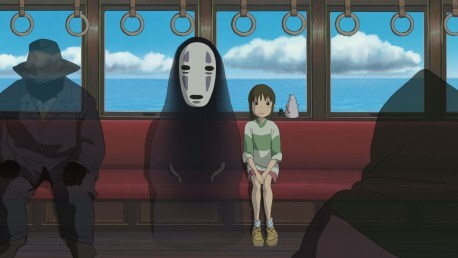
Miyazaki’s Spirited Away shows how every story is myth: each character symbolizes an aspect of the self, from the shadow in No-Face to the inner child in Boh. (Spirited Away (2001), Studio Ghibli.)
And in a more realistic example, we can see how the various characters in Pride & Prejudice represent facets of a single psyche:
Elizabeth and Darcy embody the central tension between pride and humility, shame and love.Jane reflects openness and generosity.Lydia personifies unchecked impulse.Mr. Collins plays the part of obsequious conformity.Lady Catherine stands as rigid authority.Read this way, Austen’s novel becomes not just a social comedy but an archetypal drama of the self learning to reconcile its contradictions and move toward wholeness.
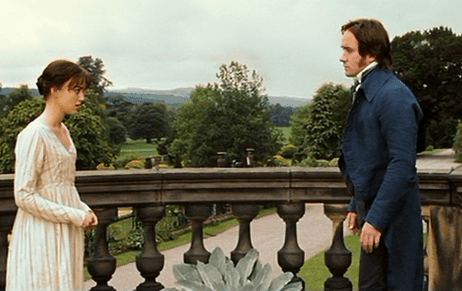
Lizzie and Darcy reflect the psyche’s struggle with pride, shame, and connection. (Pride & Prejudice (2005), Focus Features.)
Archetypes as Living Forces in Storytelling
Writing Archetypal Character Arcs (affiliate link)
For writers, one of the most useful tools for enlivening the power of mythic storytelling is to access the innate power of character archetypes.
With all things archetypal, it is crucial to interact with archetypes not as simplistic stereotypes but as living forces. Put simply: we don’t get to dictate what archetypes do. When we have truly accessed them, they tell us what they will do. When we have truly understood them, we feel it all the way down to our bones. Archetypes are dynamic energies peopling initiatory arcs. They surface in different guises but always point to universal human epochs.
As writers, we can access these forces consciously to deepen our character arcs, themes, and story arcs. The most obvious way we can work with these archetypes is to learn about them through the old stories. But they are found everywhere. I would go so far as to say they are found in every story that works. More than that, they are inherent—if perhaps latent—within each of us.
As human beings (and especially as human beings with active imaginations), we already have a deep understanding and recognition of these archetypal forces—if we are brave enough to face them. This cannot be taken for granted. It can often feel much easier to ignore the call of initiation and transformation. Cutting the journey short before we finish the Dark Night of the Soul can often seem wiser. Ironically, remaining cozy and cynical in the affirming arms of despair can feel much safer than daring to keep walking into the unknown of transformation.
What archetypal storytelling—mythic storytelling—demands of us as storytellers is that we face the archetypes themselves with authenticity and with humility. Mythic storytelling demands that we listen to the deepest, loudest, softest truths within us. We know when what we are writing is mythic and archetypal—whether we call it that or not. We know when what we are writing is the truest thing it is possible for us to write. We know in our hearts. And I do not say “hearts” lightly. The heart is a much better storyteller than the head.
The head, however, remains a worthy ally on this journey. It is not, as it so often thinks, the protagonist. But it is a helpful sidekick. To that end, studying the mythic journeys in literature can be extremely helpful—whether the Hero’s Journey or the five further archetypal journeys I discuss in my book Writing Archetypal Character Arcs. (Writers can apply these insights practically through my Archetypal Character Arc Worksheets. This worksheet bundle is, in essence, a companion workbook to Writing Archetypal Character Arcs. If you’d like help charting any of the six archetypal character arcs—Maiden, Hero, Queen, King, Crone, and Mage—you can check out the worksheets I just released. If you want them all, be sure to check out the discounted bundle.)

Story is not just “about life.” It’s a dream we dream together. It is a map for transformation. If we look into the past, history tells us our storytellers were our seers, our shamans, our wayshowers, our most respected elders.
Now, we are all storytellers. We all bear this great burden to look beyond what everyone else can see and to hone the transformative truths that are meant to initiate not just us but every member of our tribe.
To do that, we must start by remembering what story really is. It is not just entertainment. It is not just escapism. It is not just pleasure. It is not just a source of income.
What is story? I believe the archetypal shape of story is, fundamentally, a truth. Perhaps even the Truth. It is the power to change the world—over and over and over and over again. It is the power to change us. It is the power to bypass our limited egoic perceptions of ourselves, others, and our world and to show us into the wyrdest depths of what it means to be human. It is a dream we dream that also dreams us. It is initiation. It is transformation. It is change. It is myth.
Frequently Asked QuestionsWhat does it mean to say all stories are myth?It means that beneath every plot and genre lies a universal archetypal pattern. From epic fantasies to contemporary romances, all stories echo mythic structures that reflect the psyche’s journey of transformation.Can hyper-realistic stories still be mythic?
Yes. Even the most realistic fiction carries symbolic depth if the writer taps into archetypal storytelling. A courtroom drama or slice-of-life novel can still follow the mythic blueprint of initiation, transformation, and return.Why do archetypes resonate so deeply with readers?
Because archetypes are not stereotypes. They are living psychological forces. When writers use archetypal character arcs, readers feel as though they are watching their own inner conflicts dramatized on the page.How can writers use archetypal character arcs in their stories?
Writers can use arcs like the Maiden, Hero, Queen, King, Crone, or Mage as blueprints for character development. These journeys help ensure stories resonate with mythic power and emotional authenticity.In Summary
At their core, all stories are myth. No matter the genre or style, narrative always springs from the archetypal blueprint of the psyche. Story is not simply a mirror of everyday life but a symbolic map of transformation—a dream we dream together. When writers embrace this mythic foundation, they create stories that not only entertain but initiate both writer and reader into deeper self-awareness and lasting change.
Key TakeawaysAll stories are myth. Beneath plot and genre lies the archetypal blueprint of transformation.Story is psyche. Every character and force reflects a facet of the self.Archetypes are alive. They are not tropes but dynamic psychological energies.Hyper-realism needs myth. Realism alone risks losing depth; archetypal foundation restores resonance.Story transforms. Writers and readers alike undergo initiation through narrative.Want More?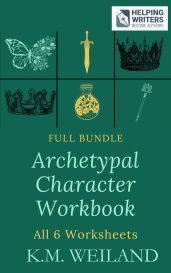
Archetypal Character Workbook (Full Bundle of 6)
If you’d like to put these insights into practice, explore my Archetypal Character Arc Worksheets—a series of six fillable, downloadable guides designed to help you chart mythic journeys for your characters. Each worksheet breaks down one of the six archetypal arcs—Maiden, Hero, Queen, King, Crone, and Mage–into structural beat sheets, reflective questions, and story prompts. Whether you’re writing epic fantasy or modern literary fiction, these tools will help you harness archetypal storytelling, deepen your characters, and unlock the mythic power within your narrative. Find the full set (including the discounted bundle) in my Etsy store.
Wordplayers, tell me your opinions! Do you see your own stories as mythic at their core? How do you think recognizing the archetypal foundation of storytelling might change the way you write? Tell me in the comments!Click the “Play” button to Listen to Audio Version (or subscribe to the Helping Writers Become Authors podcast in Apple Podcast, Amazon Music, or Spotify).
___
Love Helping Writers Become Authors? You can now become a patron. (Huge thanks to those of you who are already part of my Patreon family!)The post Why All Stories Are Myth—and How They Transform Us appeared first on Helping Writers Become Authors.
August 30, 2025
New Worksheets for Writers: Fillable PDFs to Spark Your Story
Sometimes the “quick little projects” are the ones that surprise me the most! Back in the spring, I thought it might be fun to put together a few simple printable writing worksheets—something light and easy, just a side project before the second edition of my Structuring Your Novel Workbook comes out this October.
Of course, you know how that goes.  One idea led to another, and before long my “tiny project” turned into a whole collection of 20+ digital writing resources. And honestly? I had a blast making them. (Seriously. I had to make myself stop!)
One idea led to another, and before long my “tiny project” turned into a whole collection of 20+ digital writing resources. And honestly? I had a blast making them. (Seriously. I had to make myself stop!)
Now, after months of work, I’m excited to share them with you!
Why I Created These Worksheets for WritersWhen I was in grade school, I had a “Write Your Novel” kit that came with worksheets. I can still remember how excited I felt sitting down with those pages—answering questions, filling in blanks, and dreaming up characters and stories. Secretly, that early love of worksheets has never left me. To this day, I still find them ridiculously fun.
Of course, worksheets should never be about ticking off boxes or forcing your story to fit into rigid rules. Writing begins and ends as discovery. But sometimes we all hit blind spots:
An arc that feels flatA theme that won’t come togetherA character who just isn’t coming aliveThis is where worksheets shine. Worksheets are tools to help you spark fresh insight, troubleshoot weak spots, and unlock ideas you didn’t know you had.
My goal was to design practical, easy-to-use tools that:
Give you direct access to the writing techniques I teachSpark new insights into your characters, themes, and plotsOffer flexible, fun ways to brainstorm and outline your storiesWhether you’re working on a novel, screenplay, or even an RPG campaign, these fillable PDF worksheets for writers are designed as creative companions for your storytelling journey.
 Browse the entire collection of 20+ worksheets here: [Grab the Worksheets!]
Browse the entire collection of 20+ worksheets here: [Grab the Worksheets!]
If you’re not sure where to start, I’d recommend checking out two special bundles:
The Archetypal Character Arc Cheat Sheets – Provides quick-glance guides to all six of the major archetypes in the Archetypal Life Cycle. For those of you have been asking, this is really a companion workbook for Writing Archetypal Character Arcs . (And, who knows, if you love the digital worksheets, my next project may be collecting them into a paperback!) The Enneagram Character Arc Cheat Sheets – An 18-worksheet collection for creating powerful arcs (both Positive and Negative) for all nine personality types.Both bundles are steeply discounted so you can grab them at the best value, rather than purchasing each worksheet individually.
After that, here are a few standouts I think you’ll love:
Character Interview Worksheet – 100+ questions to dig deep into your protagonist’s psychology, habits, and quirks. Perfect if you want to truly know your character inside and out. Supporting Character Interview Worksheet – 30 targeted questions for side characters, because your story world comes alive only when all the characters feel real. Character Arc Quick Guide – Beat sheets for all five major arc types (Positive, Flat, Disillusionment, Fall, and Corruption). A handy way to clarify your character’s journey at a glance. Story Structure Beat Sheet – A step-by-step breakdown of the classic seven-beat structure. Use it to tighten pacing or map out missing beats. Theme Worksheet – A 12-page guided exploration of your story’s thematic heart, with resources on character arcs, core elements, and dozens of bonus links.What’s Inside the Worksheets for Writers (The Bonuses!)These aren’t just worksheets—they’re mini writing toolkits. Each one comes with an extensive PDF resource guide packed with links to my most helpful blog posts, podcast episodes, and free tools. That way you can dig deeper into the craft while putting ideas directly into practice.
You’ll also find extras like:
Quick-reference infographics to keep story structure principles at your fingertipsExpanded guidance for flexible worksheet useTips and curated examples to inspire your processSince this is a brand-new launch, your support means so much! You can purchase the worksheets directly from my store, but I’d especially appreciate if you order through my Etsy shop. Every purchase there helps me build credibility and visibility on the platform.
And if you find the worksheets helpful, leaving a quick review on Etsy would be an enormous help in boosting the shop’s ranking!
I made these worksheets with you in mind, and I hope they give you the same spark of excitement I felt while creating them. I can’t wait to see what stories they help you bring to life!
 Explore the new worksheets here: [Worksheets Here!]
Explore the new worksheets here: [Worksheets Here!]
The post New Worksheets for Writers: Fillable PDFs to Spark Your Story appeared first on Helping Writers Become Authors.
August 25, 2025
What’s Happened to Modern Storytelling? (+ 6 Ways Storytelling Can Find Its Soul Again)
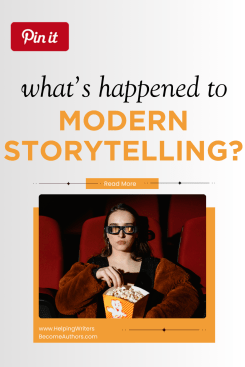 I’ve been feeling it for a while now—that dull, uninspired thud when the credits roll on modern storytelling. More and more, movies in particular leave me feeling unmoved and oddly detached. Bored, really. Once upon a time, I’d walk out of the theater buzzing. I’d carry that story around with me for days, sometimes weeks. I called it a “story high.”
I’ve been feeling it for a while now—that dull, uninspired thud when the credits roll on modern storytelling. More and more, movies in particular leave me feeling unmoved and oddly detached. Bored, really. Once upon a time, I’d walk out of the theater buzzing. I’d carry that story around with me for days, sometimes weeks. I called it a “story high.”
Now? More often than not, I’ve forgotten the movie by the time I reach the parking lot. Actually, most of the time I’m lucky if I remember whatever it was I watched on Netflix last night.
I keep asking myself, “Is it me who has changed?” Because God knows I have. This past decade has transformed almost everything about my life, including my relationship to my own storytelling. So perhaps what I’m experiencing is just “taste drift.” Or has something in the very DNA of our storytelling shifted? Is the drift I’m feeling really that the tilt toward spectacle, franchise maintenance, and safe, surface-level beats has taken all the magic with it?
I’ve been pondering this for a long time now, and I’ve been dancing around this post for a while too—wondering if it’s too shaded by my own subjectivity or, perhaps more tellingly, my own nostalgia and idealism. But you know what? I’m just gonna say it: I miss the way movies used to be.
I’m tired of feeling bored by something that used to delight me to no end. I’m sick of feeling a lack of engagement. I’m exhausted by the magnetism movies fail to hold for me. I used to get butterflies watching movie trailers. Now sometimes I can’t even be bothered—because even if the trailer looks good, will the movie really live up to expectations? Do I really even have expectations any longer???
The bottom line is this: it’s been a long time since more than the occasional and very random new movie (and I’m lumping in all TV and streaming content here) actually made me feel something. I know it’s not just me, because when I go back to the oldies, the difference is palpable. And in my very subjective opinion, it’s time we got back to telling stories the way we used to.
In This Article:What’s Happened to Modern Storytelling?The Impact Movies Have on BooksThe Storytelling Cycle 1970–20256 Qualities Storytelling Is Ready to See AgainWhat’s Happened to Modern Storytelling (Especially Movies)?Well, COVID happened, social media happened, streaming happened, the writers’ and actors’ strikes happened. All those things have massively affected the bottom line of how this very expensive medium is constructed to reach its audience.
But you know what? I don’t even think that’s really it.
When I examine the filmmaking landscape of the last 10–20 years in comparison to the decades that came before, what jumps out at me is the tone.
For a long while now, so much of what we’re offered to consume as storytelling audiences has been overlaid with tones of:
SnarkIronyMeta-commentaryHyper self-awarenessNihilismDeconstructive narrativesNow, admittedly, we’re living in an era of deconstruction, and I don’t necessarily see that as a bad thing. Cycles are made to turn. We need the sour with the sweet. We need the bracing cold against the lazy warmth. Idealism needs a sharp shot of cynicism every now and then. But by that same principle, cynicism eventually needs idealism to take its shot right back. Just as we cannot construct endlessly, neither can we deconstruct ad infinitum.
The Impact Movies Have on BooksBefore I go on, let me say a word about our other important storytelling medium: books. Most specifically in this post, I am referencing the current filmmaking culture in the U.S. However, because of the undeniable influence this visual media has on art of all kinds, we can’t fully separate its struggles or trends from those we find in literature.
In no small part, writing is “monkey see, monkey do.” Even those of us writing novels and short stories are inevitably influenced not just by the books we read, but I would argue perhaps even more so by the visual media we consume. Visual media is not only pervasive, it’s also unparalleled for its memorability. I suppose this is particularly true for visual learners. Speaking for myself, I can say with certainty that the visuals I consume are perhaps the single greatest influence on my storytelling.
More than that, as a comparatively snack-sized consumable, movies and even limited series are, in my opinion, unquestionably the greatest influence upon storytelling structure and techniques for modern writers. In short, what begins in the movies will eventually affect literature.
That said, I don’t feel these concerning trends are as obviously prevalent in literature as in film. Part of the reason for this is that salable literature is a vast landscape in comparison to salable visual media. Mostly, this is because the stakes aren’t as high. Strictly speaking, it costs nothing to create a book in comparison to the staggering millions dropped on visual spectacle. This alone makes books a far more forgiving medium in which to experiment and stretch the bounds of convention or audience expectation.
The book-reading experience can also be much more subjective in its personalization. People are far more likely to be watching the same movies and shows than they are to be reading the same books. Those books we have all read—whether classics or bestsellers—have sometimes been baptized in the fires of public scrutiny a bit more thoroughly than the latest film we’ve “all” seen.
So with all that said, although my own recent experiences with modern novels have been largely more positive than with modern movies, the general downturn in the filmmaking industry certainly crosses over to some extent—making these concerns more about “storytelling” in general than simply “filmmaking.”
The Storytelling Cycle: 1970–2025
Click for larger view.
Although I am undeniably nostalgic for the movie landscape of my teenage and young adult years, the changes I’m picking up on point to more than just that. If we look back just fifty years or so, at the overall storytelling cycle, we can see a clear oscillation:
1970s – Grit & DisillusionmentTone: Cynical realism, moral ambiguity, personal stories.
Examples: The Godfather, Taxi Driver, One Flew Over the Cuckoo’s Nest
Drivers: Post-Vietnam, Watergate, social upheaval. Audiences suspicious of authority. Anti-heroes dominate.

The Godfather (1972), Paramount Pictures.
1980s – Mythic Optimism & Pop EscapismTone: High-concept, archetypal, sincere adventure.
Examples: Star Wars, E.T., Back to the Future, The Princess Bride
Drivers: Blockbuster economics, Reagan-era optimism, VFX advances. The rise of the Hero’s Journey as mainstream glue.
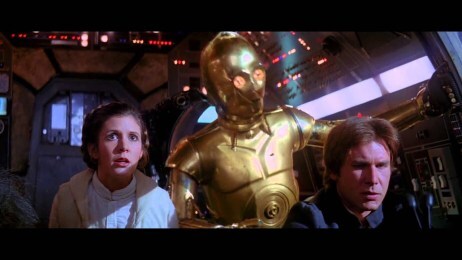
Star Wars: The Empire Strikes Back (1980), 20th Century Fox.
1990s – Irony & DeconstructionTone: Quirky realism, meta-humor, genre-bending.
Examples: Pulp Fiction, Fight Club, The Matrix, The Truman Show.
Drivers: Post-Cold War uncertainty, Gen X skepticism, indie boom. Themes interrogate reality and authenticity.

The Matrix (1999), Warner Bros.
2000s – Earnest Epic ResurgenceTone: Sweeping, sincere myth for a new millennium.
Examples: The Lord of the Rings, Harry Potter, Gladiator
Drivers: Pre-/post-9/11 yearning for unity, moral clarity. Large-scale adaptations brought back allegory and grand stakes.
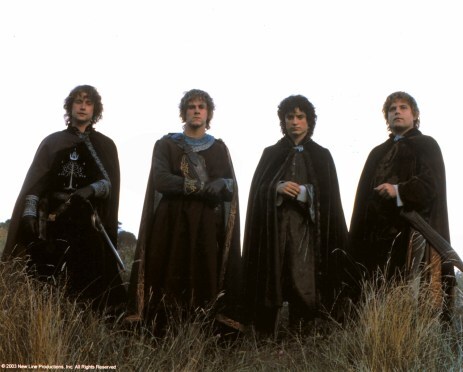
The Lord of the Rings: The Return of the King (2003), New Line Cinema.
2010s – Meta-Franchise EraTone: Connected universes, quippy self-awareness, formula mastery.
Examples: MCU Phases 1–3, Frozen, Game of Thrones.
Drivers: Social media feedback loops, globalization, IP exploitation. Themes (and conclusive arcs) are often secondary to brand continuity.

The Avengers (2012), Marvel Studios.
2020s – Saturation, Fragmentation, & CautionTone: Brand maintenance, “safe” messaging, heavy serialization, frequent irony to preempt critique.
Examples: MCU Phase 4, Disney’s Star Wars, Rings of Power, The Witcher, Disney’s live-action reboots.
Drivers: Pandemic shifts viewing habits, political polarization, streaming war economics, strikes. Thematic depth appears in pockets (e.g,. Dune), but most mass-market fare is either spectacle-first or message-first.

The Witcher (2019-), Netflix.
6 Qualities Storytelling Is Ready to See AgainSo are we at the end of the current cycle? Are we ready for a resurgence of idealism, hope, wonder, and optimism? Hard to say. Ultimately, I believe these things take as long as they need to take to work their archetypal and energetic perogatives within the overall cycle. But, personally, I think we’re ready. I think it’s time. God knows I’m ready for it as a viewer. More than that, I know this is what I want to write. If I get to have a contribution to the never-ending story of this cycle, then I know this is what I want it to be.
If you’re ready to hop on this train as it’s getting ready to leave the station, here are six qualities I think it’s past time we bring back to mass media.
1. Subtext, Metaphor, and Allegory
Writing Your Story’s Theme (Amazon affiliate link)
If I think about one element that is the hallmark of every movie I’ve ever loved, it’s this: it’s subtext. So much of we’re seeing today is either on-the-nose or deliberately subverting its own subtext to create meta references or irony. Story’s richest depths live in subtext. The best stories are about more than just the text. Their subtext offers thematic symbolism with the capability of turning even the simplest story into something deep and true. This is the power of allegory. It is the power of thematic metaphor. Even though all stories offer the potential for this, it actually takes a tremendous amount of courage for a storyteller to resist the urge to simply spell it all out.
When I speak about this, I think about movies like The Legend of Bagger Vance, The Lion King, and Forrest Gump. But even obviously blockbuster stories such as Jurassic Park and The Terminator elevate themselves into timeless and unforgettable experiences through their subtextual expertise. This stands in such blatant contrast to their resurrected franchise sequels—most of which, despite all their bling, are heartless, soulless, and (because you don’t get the first two without this one:) brainless.

Forrest Gump (1994), Paramount Pictures.
2. Mythic Structure and Archetypal Resonance
Writing Archetypal Character Arcs (affiliate link)
Mythological and archetypal underpinnings lay the foundation for stories of effortless truth. They point to what is most real, and they supply the kind of symbolism that takes audiences deep without even trying. Solid plot structure and character arcs start this off (as they are themselves rooted in myth and archetype), but there is so much more depth we can explore.
It’s true the old stories need to reinvent and resurrect themselves from time to time—or more strictly, culture needs to reinvent its relationship to these stories. We can get so close to them, we begin to think they are “tame lions” and we forget that what they really represent is something terrifyingly beautiful in its raw and primal power.
Our relationship to these structures evolves. But really it is us who evolves more than the structures themselves. I was reminded of this in recently viewing StudioBinder’s excellent retrospective of the Hero’s Journey (in which I was honored to appear):
It is arrogance that lets us think, in all our perky snark and world-weary cynicism, that we write the stories. No, the stories write us. We forget that at our peril, and as storytellers we, above all, safeguard the chthonic depths of our deepest, most terrifying, and most transcendent truths.
The great myths of our age have been movies (either first or perhaps most prevalently): Star Wars, Lord of the Rings, Harry Potter. And they have changed us utterly. For this reason, if no other, I will never be content with even one single story that does not confront me, does not make me feel something, does not transform me.
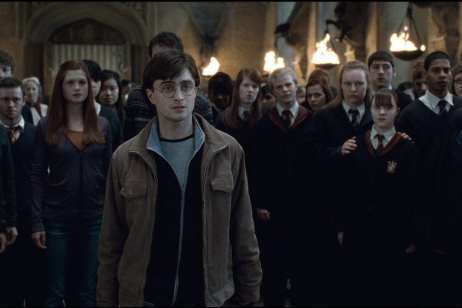
Harry Potter and the Deathly Hallows – Part 2 (2011), Warner Bros.
3. Emotional Sincerity, Vulnerability, and EarnestnessThis one isn’t always popular. But, honestly, I feel the truth of it deep in my bones: we are missing stories that confront us with emotional sincerity, with vulnerability, and, yes, with earnestness. We’re so jacked on sarcasm and skepticism. Perhaps it began as a tool to transform structures that had seen their day. But now, it’s starting to feel like a defense we’re just hiding behind.
There’s no hiding from hope—the hope that we will be seen, accepted, loved—not for who we are supposed to be, but just as we are in all our messy glory. Think about how hard it is to show up with your heart in your hand.
Although we certainly do see many films these days striving for this (and kudos to them), I can’t help feeling many are still hiding a bit behind their own weariness and tragedy. Sometimes simplicity and innocence and even happiness can feel the most vulnerable of all. I’m thinking of films like Big and Ferris Bueller’s Day Off. These are simple—and in some ways very disruptive—comedic romps that reach far beyond themselves through their willingness to show up in the full earnestness of the human capacity for hope and faith.

Ferris Bueller’s Day Off (1986), Paramount Pictures
4. Moral Clarity (With Nuance)Oh, yes, movies today have a certain moral clarity. At least, they like to tell you exactly what they think (see above about no subtext) and probably exactly what you should think too. Examples abound, from all perspectives. And, frankly, they’re all bad. But then we’ve also got a lot of post-modern confusion going on, and literally a slew of stories whose ambiguity leaves you wondering at the end if there even was a thematic message.
I’ve always liked to say, “Stories are better as questions than as answers.” I still stand behind that. Heavy-handed moralism goes hand in hand with no subtext, and it never works out well. But that doesn’t mean stories can’t (and shouldn’t) have something to say and to say it with all the conviction and nuance they can muster.
Think about Schindler’s List, Amadeus, every John Hughes film ever made, even Bill and Ted’s Excellent Adventure for crying out loud. These stories know what they are and what they’re trying to say about the world. They say it with assurance, and they offer the package up for us to have our own experiences and make our own judgements.

Schindler’s List (1993), Universal Pictures.
5. Joy and Wonder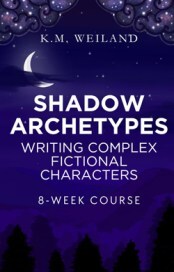
Here’s another one that isn’t always praised in our modern film-going culture. But, by God, we need it. Of late, we have been in a time and a place where we have needed to stare down our shadows. But I think it’s time to remember why. Why do we face our shadows? What’s the point? Why is it worth it?
Every story faces its Point of No Return, its Moment of Truth, and its Dark Night of the Soul so it can emerge at the end transformed. The shadow transformed is always light.
I mentioned at the beginning of the article that it’s been a while since I’ve seen a film that really made feel something. If I’ve felt anything at all, it was probably some type of catharsis—grief, anger, shock, disgust. It’s been much longer since a film has taken me to that place of joy and wonder—that revelry just in being alive.
Star Wars did that for me, some of the early MCU movies did that, Secondhand Lions always does that. But these stories don’t have be romps. Joy is always waiting for us at the end of It’s a Wonderful Life, just as wonder waits for us at the end of Princess Mononoke.

It’s a Wonderful Life (1947), Liberty Films.
6. Goodheartedness
The Hero With a Thousand Faces Joseph Campbell (affiliate link)
Finally, I am reminded of what Joseph Campbell had to say about the quality of goodheartedness as a necessary quality of anyone who would succeed upon the Hero’s Journey. He spoke of the Irish folk hero Niall, who won his crown through the simplicity of goodheartedness as demonstrated in his kindness to a seeming old crone who was then transformed into the beautiful archetypal force capable of granting him the “Royal Rule.”
Now, don’t get me wrong. I am a friend to the shadows. I believe wholeheartedly in the necessity and courageous importance of facing our shadows—which, in so many ways, is what we are being called upon to do in this moment in time—and reintegrating them into a greater wholeness. All stories reflect humanity’s never-ending struggle with this transformative process. Some parts of the storytelling reflect one aspect; some another.
But even in the midst of our darkest shadow work, may we never forget the crucial piece that is goodheartedness. As storytellers, we bear the great burden of the world’s catharsis—the grief, the anger, our most violent and abhorrent proclivities. But part of that, too—and I would say the most important part—is also the tether to something deeper and truer and better and kinder.
May we write stories like Lord of the Rings and Anne of Green Gables and The Breakfast Club and E.T. and Little Women and Star Wars and Driving Miss Daisy and Harry Potter and Groundhog Day. May we write stories about the heroes we wish we were, the compassion we wish we had, the courage to transform, and the supreme gratitude with which to accept all the glory that is life.
Those are the movies I want to watch again. That’s how you put the whole world on a story high.
In Summary: Why Stories Must Find Their Heart AgainOver the past fifty years, storytelling has swung like a pendulum—from grit and cynicism to myth and wonder, and back again. Right now, we’re in a season of fragmentation, irony, and surface-level spectacle. But history suggests the cycle always turns. What’s missing today (and what audiences are aching for) is a return to sincerity, subtext, allegory, and stories that dare to make us feel something real.
Key TakeawaysModern movies often feel hollow because spectacle has replaced subtext.Storytelling moves in cultural cycles: grit → myth → irony → sincerity.We’re likely on the cusp of another turn toward earnest, mythic storytelling.Writers and filmmakers can be part of that shift by embracing sincerity, allegory, and goodheartedness.Want More?If this resonates, check out my Shadow Archetypes email course. Over eight weeks, we’ll explore the passive and aggressive shadow polarities of the six main archetypes in the Archetypal Life Cycle. It’s a deep dive into how the darker sides of our characters (and ourselves) shape narrative truth. You can sign up here.
Wordplayers, tell me your opinions! What do you think happened to modern storytelling? Do you feel the same hollow note I’ve described, or do you think the magic is still out there if we just know where to look? Tell me in the comments!Click the “Play” button to Listen to Audio Version (or subscribe to the Helping Writers Become Authors podcast in Apple Podcast, Amazon Music, or Spotify).
___
Love Helping Writers Become Authors? You can now become a patron. (Huge thanks to those of you who are already part of my Patreon family!)The post What’s Happened to Modern Storytelling? (+ 6 Ways Storytelling Can Find Its Soul Again) appeared first on Helping Writers Become Authors.
August 18, 2025
Writing Better Character Conflicts With the 5 Conflict Management Styles
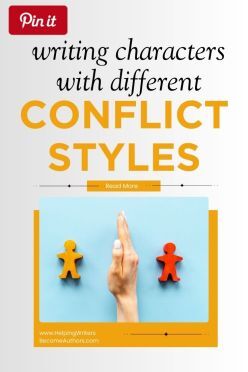 Note From KMW: Before we get started today, I just wanted to let you know that this weekend, I’m excited to be sharing a presentation at the WorldShift: The Speculative Fiction Writers’ Summit 2025. This is a free, 4-day online event packed with workshops on character, worldbuilding, plotting, publishing, and more from 30+ writing experts. Whether you write speculative fiction or not, you’ll walk away with tools you can use in any story. You can grab your free ticket here: Join the Summit.
Note From KMW: Before we get started today, I just wanted to let you know that this weekend, I’m excited to be sharing a presentation at the WorldShift: The Speculative Fiction Writers’ Summit 2025. This is a free, 4-day online event packed with workshops on character, worldbuilding, plotting, publishing, and more from 30+ writing experts. Whether you write speculative fiction or not, you’ll walk away with tools you can use in any story. You can grab your free ticket here: Join the Summit.
***
In fiction, every clash between characters comes down to a conflict management style. This is true whether you’re writing a heated argument or a quiet standoff. In real life, psychologists group these into five main approaches: competing, collaborating, compromising, accommodating, and avoiding. Understanding how each works can help you write richer, more realistic character conflicts.
It is a common axiom in the writing world that conflict drives story. Although the simplicity of this advice is necessarily limited, what it means is that plot is created from a series catalysts that cause characters to respond. Basically: cause and effect.
This is what then creates the chain of story events (aka, scenes) that engenders the larger story. At its simplest, story conflict is nothing more or less than some kind of obstacle interfering with a character’s forward progression. That said, the word “conflict” itself does tend to most readily connote interpersonal conflict—whether in the form of a fistfight or a passive-aggressive argument. Indeed, most people find this aspect of conflict to be the most obviously entertaining and useful for plot, since it tends to inherently combine all three of a story’s major engines: plot, theme, and character.
This means that much of what writers need to know about conflict in general comes down to character conflicts. The more nuanced your characterizations, the more interesting the conflict will be and the more realistic and compelling your characters will be.
So how do you create nuanced character conflict?
One way is to study and understand conflict management styles. If you can figure out which conflict management styles best fit your characters, you not only have the opportunity to create instantaneously complex relationship dynamics (since every character’s approach to conflict will be different), but also conflict that naturally arises from the management styles themselves (e.g., characters with opposing styles can sometimes spark conflict just because they clash with each other’s approaches).
In This Article:Take the Test: What Are the 5 Conflict Management Styles?Using the 5 Conflict Management Styles to Build Character ConflictThe Competing Style: High-Stakes ShowdownsThe Collaborating Style: Win-Win SolutionsThe Compromising Style: Meeting in the MiddleThe Accommodating Style: The Peacemaker’s PathThe Avoiding Style: Delaying the BattleTips for Mixing Conflict Styles in Your StoryTake the Test: What Are the 5 Conflict Management Styles?The idea of five distinct conflict management styles comes from the Thomas-Kilmann Conflict Mode Instrument (TKI), developed in the early 1970s by psychologists Kenneth W. Thomas and Ralph H. Kilmann. Originally designed for workplace and organizational settings, the model maps how people handle conflict along two dimensions: how a person pursues one’s own goals (i.e., a spectrum of unassertiveness and assertiveness) and how one considers others’ goals (i.e., a spectrum of uncooperativeness to cooperativeness). From there, they used these two axes to map five core approaches to conflict: competing, collaborating, compromising, accommodating, and avoiding.
To discover which style best fits your characters (and yourself!), you can purchase the official test here. Below is a short version that can get you started by giving you the general idea:
Character Conflict Style QuizDiscover how your characters naturally handle disagreements, tension, and power struggles. Start by choosing a single character you want to assess. For each statement below, imagine how this character would respond in a variety of situations (e.g., with friends, rivals, strangers, etc.).
Rate each statement on a scale of 1–5:
1 = Strongly Disagree
2 = Disagree
3 = Neutral / Sometimes True
4 = Agree
5 = Strongly Agree
At the end, follow the scoring guide to discover your character’s dominant conflict style(s).
The StatementsMy character pushes hard for his/her own way, even if it risks upsetting others.My character seeks solutions that work for everyone involved in the disagreement.My character will give up part of what he/she wants if it helps resolve the conflict.My character often lets others have their way to keep the peace.My character avoids bringing up issues unless there’s no other choice.My character enjoys finding creative solutions in which everyone feels satisfied.My character is willing to settle halfway if it ends the argument quickly.My character puts the other person’s needs first when harmony matters most.My character changes the subject or withdraws to avoid escalation.My character insists on his/her own position, believing he/she’s right.ScoringAdd the scores for each style category:
Competing = Q1 + Q10Collaborating = Q2 + Q6Compromising = Q3 + Q7Accommodating = Q4 + Q8Avoiding = Q5 + Q9Highest Score → This is your character’s dominant style in conflict.
Close Second(s) → These could be secondary style(s) your character may use in certain situations.
Lowest Score(s) → These are the styles your character is least likely to use.
Use the dominant style to shape your characters’ dialogue, body language, and choices in tense scenes. From there, you can play with your story’s conflict by putting your characters in situations that force them into their weakest styles. Not only does this usually create more conflict, but it’s great for growth arcs and plot twists. Also, look for ways to combine different styles in ensemble casts to create natural friction between characters.
Understanding conflict management styles for your characters can provide a solid foundation that influences many aspects of your story. This lays the groundwork for realistic personalities, while also contributing to how you manage each scene’s tension, pacing, and tone. It will influence how character relationships play out, and—since this is usually the heart of any story—from there it can end up creating the plot all by itself.
If you realize any one character lacks a strong conflict style and/or many of your characters share the same style, you can easily troubleshoot for a stronger narrative by mixing things up or strengthening the accuracy and consistency of how a particular conflict style is showing up in your story.
Using the 5 Styles Conflict Management Styles to Build Character ConflictLet’s take a deeper look at each of the five styles and how each one might show up in your fiction.
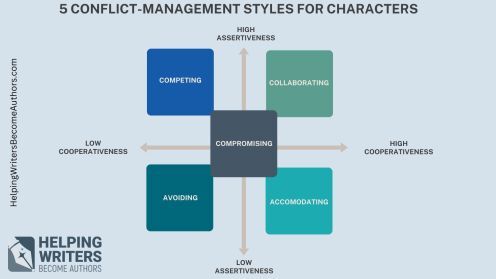
5 Conflict Management Styles for Writers Graph (click for larger view).
1. The Competing Style: High-Stakes ShowdownsCharacters with a Competing style go all in to get what they want. They score high in both assertiveness and uncooperativeness, which means they tend to prioritize victory over relationships. This can be a great way to raise the stakes, since it creates scenarios with clear winners and losers.
Although these characters often come across as selfish, they can also be excellent leaders since they are ultimately all about efficiency. Their focus is entirely on getting results, which can actually be on behalf of someone else (i.e., protecting or providing for the group) even if relationships are often not factors in the decision making.
For Example:
Miranda Priestly in The Devil Wears Prada relentlessly pushes her own agendas, regardless of how it impacts others. When she demands Andrea obtain an unpublished Harry Potter manuscript for her twins, Miranda exerts total control, making it clear her needs come before anyone else’s.
The Devil Wears Prada (2006), 20th Century Fox
Captain Ahab in Moby-Dick obsessively pursues his own goal (killing the whale), even at the cost of his crew’s safety. He rallies the crew to join his hunt for Moby-Dick, overriding the ship’s original mission and dismissing the first mate Starbuck’s concerns.

When two characters team up to find a solution that works for everyone, they’re Collaborating. Unlike the Competing style, the Collaborating style can often serve to strengthen connections even while highlighting differences. Like Competitors, Collaborators score high in assertiveness. They’re there to get the job done, but because they also score high in cooperativeness, they wish to do so in a way that doesn’t clearly define themselves as winners and everyone else as losers.
These characters make great leaders, although usually more heart-based than the head-based Competitors. Sometimes their downfall can be trying to make situations work for everyone when that isn’t possible or desirable (which can ironically cause everyone to “lose”).
For Example:
As she becomes a leader, Moana works to find solutions that honor her people’s traditions while also solving their urgent needs. When she realizes the antagonist is actually the goddess Te Fiti, Moana does not seek to defeat her, but rather restores her heart, resolving the conflict in a way that benefits everyone.
Moana (2016), Walt Disney Pictures.
Atticus Finch in To Kill a Mockingbird strives to seek truth and fairness by balancing empathy with justice and involving others in the moral conversation. During his courtroom defense of Tom Robinson, he appeals to the jury’s conscience and shared values in an attempt to gain a resolution that serves both justice and his community’s moral integrity.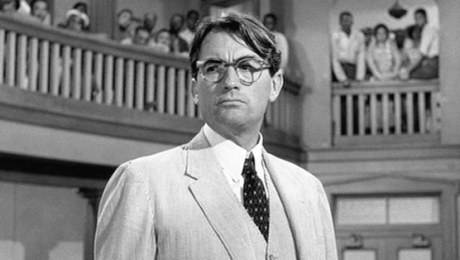
To Kill a Mockingbird (1962), Universal Pictures.
3. The Compromising Style: Meeting in the MiddleThis style desires both sides to give a little and meet in the middle. Compromisers tend to create a partial resolution that still leaves some tension in play. Compromisers ride the middle of both axes—assertiveness and cooperation—landing somewhere betwixt and between. Because they lack as much assertiveness as Competitors and Collaborators, they tend to fill leadership roles only reluctantly and in the absence of someone more decisive. This isn’t necessarily because the more decisive types are better leaders, but because those types can sometimes fill the role faster, while the Compromising type is still examining all the options.
The Compromising style can often lend itself to indecision. Because their greatest desire is for everyone to be happy, they can get stuck in pursuit of an impossible ideal. They can be frustrating to both assertive types, but offer valuable and necessary perspectives.
For Example:
Marty McFly in Back to the Future consistently seeks middle-ground solutions to avoid outright confrontation, like persuading George to stand up to Biff so he doesn’t have to directly fight Biff himself, or finding a way to get the time machine running without demanding perfection from Doc.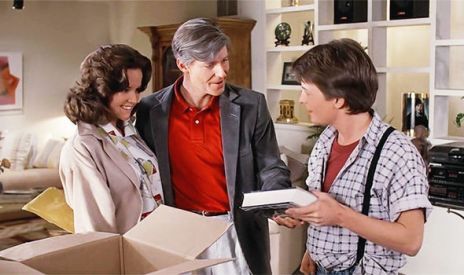
Back to the Future (1985), Universal Pictures.
Katniss Everdeen in The Hunger Games often negotiates partial agreements with allies (like Peeta or Haymitch) to survive, while still holding to her values. Although she will fight if pushed (indicating a secondary conflict style), she generally prefers to find workaround solutions.
The Hunger Games (2012), Lionsgate.
4. The Accommodating Style: Seeking PeaceSometimes a character will give in to keep the peace, a choice that can alternatively reveal loyalty, fear, or quiet acts of self-sacrifice. This conflict style scores low in assertiveness and high in cooperativeness. Although this style often lends itself to characters who can get run over by more assertive types, it also represents the most empathetic of the five. This is usually a person who is highly tuned in to others.
However, their conflict aversion can make it difficult for them to get what they want or to pursue (or sometimes even acknowledge) their own desires. If they don’t have a strong secondary style to help them out, they can (ironically) struggle to create enough conflict to drive the plot.
For Example:
Samwise Gamgee in The Lord of the Rings shows Accommodating tendencies in his dedication to putting Frodo’s needs and safety above his own desires, even when it’s hard, such as on Mt. Doom when he gives Frodo the last of their water instead of taking it himself, prioritizing Frodo’s needs over his own survival. However, Sam also shows a strong secondary Competitive style, especially when confronting Gollum.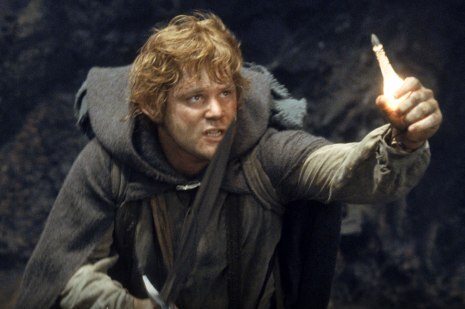
The Lord of the Rings: The Return of the King (2003), New Line Cinema.
Beth March in Little Women consistently yields to her sisters’ wishes in order to maintain family harmony, even at personal cost. For instance, when Meg is invited to a party, Beth encourages her to go even though it means Beth will left be alone.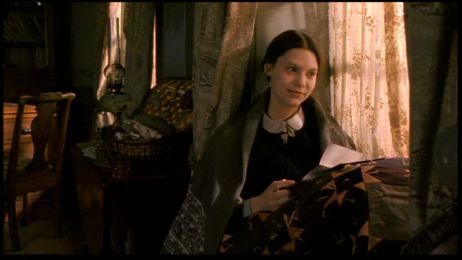
Little Women (1994), Columbia Pictures.
5. The Avoiding Style: Delaying the BattleFinally, instead of facing the issue, a character might dodge the conflict entirely. Although this can totally deflate a scene’s conflict, it can also lend itself to subtextual passive-aggression as the tension builds in the silence and unresolved emotions linger. Notably, although this type scores low in assertiveness, it scores high in uncooperativeness.
This style often lends itself to loner characters who prefer to go their own way rather than engage with others. It is separate from the Accommodating style in that it is more concerned with protecting itself than placating others. The true Avoidant style will also do almost anything to avoid conflict. It would rather slip away (either physically or by disassociation) than bond or fight in order to end the dispute.
For Example:
Christopher McCandless in Into the Wild consistently sidesteps the deep conflict of his strained family relationships, instead physically removing himself by leaving home and embarking on a solo journey into the wilderness. His avoidance defines not just isolated moments, but his entire approach to life’s tensions.
Into the Wild (2007), Paramount Vantage
Bruce Banner in The Avengers keeps a low profile in Calcutta, tending to patients and dodging any situation that might trigger his transformation. His alter-ego, the Hulk, of course, displays the opposite conflict style of Competitor.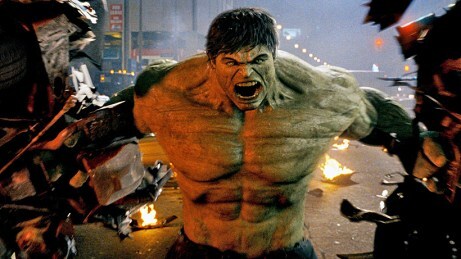
The Incredibles (2004), Walt Disney Pictures.
Tips for Mixing Conflict Styles in Your StoryAlthough most characters will demonstrate a primary conflict style, this doesn’t mean they can’t utilize secondary tactics as well. Usually, secondary tactics will represent a less well-developed (and therefore less “mature”) approach that kicks in when the primary style proves counter-productive.
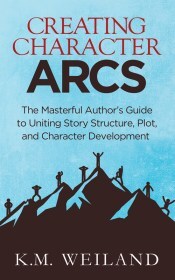
Creating Character Arcs (Amazon affiliate link)
You can use conflict styles as a central fulcrum in creating a character arc. For example, a character who relies exclusively on a Competing style might have to learn how to become less aggressive and more Cooperative. Likewise, as in Into the Wild, your story could focus on the dangers of taking any one conflict style to a tragic extreme.
One of the single best ways to utilize conflict styles in your story is to focus on the interplay between how the styles show up in different characters.
For Example:
Two Accomodating characters will probably cancel each other out, creating a scene that lacks conflict (and probably nobody getting what they want either).Two Competitive characters will be entertaining, but unless one of them arcs otherwise, their story will always end with clear winners and losers.Competitive and Collaborative leaders can create interesting stories that start with sparks and end with mutual growth.Compromising characters can often struggle in confronting other types, but offer both balanced perspectives and room for growth.With deep roots in psychology, conflict management styles make for powerful storytelling tools. By giving each character a clear, consistent approach to conflict, you can create authentic tension, natural relationship dynamics, and plot turns that feel inevitable. You may want to see your characters locking horns in a showdown or finding creative win-win solutions or slipping quietly out the back door. Whatever the case, the way they handle conflict will shape everything from pacing to theme. Mastering these five styles can help you write stories that feel more real, more layered, and far more compelling.
In SummaryThe five conflict management styles—Competing, Collaborating, Compromising, Accommodating, and Avoiding—offer writers a structured way to design believable interpersonal conflict. Each style is defined by how characters balance assertiveness (pursuing their own goals) and cooperativeness (considering others’ goals). Assigning conflict styles to characters adds depth, realism, and tension to your scenes and relationships. Going further, to mix different styles in your cast can then naturally generate friction and plot momentum. You can even shift a character’s style over time to create satisfying character arcs.
Key TakeawaysConflict drives story. Knowing your characters’ conflict styles makes that conflict richer and more organic.Different styles = different sparks. Pairing contrasting styles creates built-in tension, while matching styles can either cancel conflict or amplify it.Extreme reliance on one style can be a flaw that drives an arc or downfall.Use the Character Conflict Style Quiz to quickly identify how your characters approach disagreements.Incorporating real-world psychology models into fiction can boost authenticity and reader engagement.Want More?
Creating Character Arcs Workbook
If you’d like to take your character development even further, check out my Creating Character Arcs Workbook. Packed with guided exercises, prompts, and structure templates, it will help you chart your characters’ journeys from start to finish. It covers Positive Change Arcs, Flat Arcs, and Negative Change Arcs. Learn how to weave plot and character together seamlessly so every scene feels purposeful and emotionally resonant. It’s available in e-book and paperback.
Wordplayers, tell me your opinion! Which of your characters has the most clearly defined conflict management style, and how has it shaped relationships or the plot? Tell me in the comments!Click the “Play” button to Listen to Audio Version (or subscribe to the Helping Writers Become Authors podcast in Apple Podcast, Amazon Music, or Spotify).
___
Love Helping Writers Become Authors? You can now become a patron. (Huge thanks to those of you who are already part of my Patreon family!)The post Writing Better Character Conflicts With the 5 Conflict Management Styles appeared first on Helping Writers Become Authors.
August 11, 2025
How to Start Dictating Fiction (Even If You’ve Tried and Failed Before)
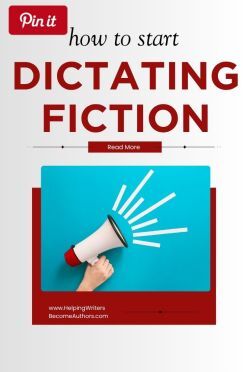 From KMW: I’ve always loved writing by hand. There’s something about the feel of pen on paper that just makes the creative process click for me, especially when outlining and brainstorming. However, between the wrist pain, bad posture, and the fact that I can’t read my own handwriting half the time, I’ll admit there are certain downsides—just as there are to typing. I’ve dabbled with dictation off and on over the years, but I always hit the same wall: it just didn’t feel like “real” writing. If I wasn’t typing or scribbling, was I actually creating?
From KMW: I’ve always loved writing by hand. There’s something about the feel of pen on paper that just makes the creative process click for me, especially when outlining and brainstorming. However, between the wrist pain, bad posture, and the fact that I can’t read my own handwriting half the time, I’ll admit there are certain downsides—just as there are to typing. I’ve dabbled with dictation off and on over the years, but I always hit the same wall: it just didn’t feel like “real” writing. If I wasn’t typing or scribbling, was I actually creating?
But as I read Sarah Elisabeth Sawyer’s guest post this week, I had to rethink that a bit. She breaks down some of the myths and mental roadblocks around dictating fiction in such a grounded, compassionate way that it made me realize something kind of obvious (but also kind of profound): storytelling was originally oral. We had voices and listeners long before we had keyboards or pens!
So if you’ve ever felt curious about dictation but haven’t been sure where to start (or, like me, have gotten frustrated after trying it), I think you’ll find Sarah’s approach refreshing. She’s been where you are, and she’s mapped out a path forward that’s both practical and encouraging. Enjoy!
***
Have you ever read about an author who dictates 5,000+ words while taking a walk and thought to yourself, “If dictation is so amazing, why isn’t everyone doing it?”
Maybe you’ve tried dictation. You opened a voice app, started talking, and… froze. It felt awkward. Disjointed. The transcription was a mess.
After working with hundreds of authors making the transition from typing to speaking their words of fiction, I know this story well. It was my story when I first tried dictation. And failed. Again and again.
Dictation is one of the most misunderstood tools for authors, yet one with potential for powerful transformation in your author life.
In This Article:4 Myths About Using Dictation to Write FictionHow to Get Started With Dictating (Even if You’ve Failed Before)The Next Step: Making Dictation Effortless4 Myths About Using Dictation to Write FictionAs someone who has dictated 14 books and trained hundreds of authors in how to dictate fiction, I want to say this: dictation isn’t a magic shortcut that will solve all your writing challenges. But it tackles a great many of them.
And dictation can absolutely be learned, just as you learned how to handwrite and type. I want you to get there without getting overwhelmed.
Let’s start by eliminating common myths around dictating fiction.
Myth #1: Dictation = Talking Fast = Writing FastWhen you think about dictation, speed is probably the first thing that comes to mind. Speed is what drew me and countless authors to give it a shot.
Dictation can help you draft faster. I doubled my writing speed from 1,500 words of fiction per hour to 3,000 words, and with less strain on my body.
But when you only see dictation as a way to supercharge your productivity, you might experience frustration and even disappointment before you’ve trained yourself to do it well.
Dictation isn’t a race to speak as fast as you can. I talk slower when dictating fiction than when I’m having a conversation.
If you find yourself slowing down to dictate, that’s normal. In fact, I encourage it. Take your time. Pause. Breathe. When you’re ready, tackle the next sentence.
Speed will come with practice.
But dictation isn’t just writing faster. There are health benefits since dictation frees you from your desk.
It can also help you break through mental blocks around your plot, develop better dialogue, and get words squeezed into the little spaces of life: doing the dishes, sitting in the car pool line, or walking the dog.
While dictation can lead to faster drafts, I’ve seen these other benefits outweigh speed.
Myth #2: “I Tried Dictation, It’s Just Not for Me.”This is the one I hear most. It was the myth that held me back for years.
Maybe you tried dictation while walking. Or you spoke your story into your phone one morning and felt completely disconnected from the words. Maybe the transcription came back such a mess, you decided it wasn’t worth the hassle.
I hear you. My first shot at dictation, I thought I was on to something. In 2013, I posted on social media how I dictated a few words of fiction, and how it could be epic. And it was.
An epic failure.
I couldn’t get past the mental and technical hurdles of speaking my words instead of typing.
I went through it all: staring at a blank screen with an equally blank imagination. I stumbled over words, dreaded hearing my voice, and had no idea how to clean up my transcriptions.
I didn’t know what I was doing and made a mess of everything.
Dictation just wasn’t for me.
But then I realized something: I needed to train myself to dictate just like I trained myself how to type. You need to dig new neural trenches in your brain to allow the words to flow through your mouth as naturally as your fingertips.
I came back to dictation in 2020. I released the pressure on my brain to dictate fiction. I started practicing by dictating my morning pages and text messages. Then I experimented with apps and methods until I found what worked for me. I stopped expecting it to immediately “feel right.”
Slowly, it started to work. I found my rhythm. I dictated a full (backstory) scene. Then a full chapter. Then a full novel.
Now, dictation is how I write my first drafts. I write faster and enjoy the process of creating fiction even more than when I typed (much more enjoyment through the “muddy middle” of a first draft where I always got stuck when typing).
Myth #3: You Need Fancy Software or EquipmentBack in the day, your only option to dictate fiction was to hire a private secretary or transcriptionist at hundreds or thousands of dollars per novel. Then it became more affordable with the entrance of Dragon Dictation at under $1,000 for unlimited novels.
I’ve never used Dragon to dictate my novels.
Nowadays, you don’t need expensive software to start. You likely already own what you need to dictate fiction at little to no cost:
A smartphone or computerA free transcription service (the one built into your device works just fine)A quiet space (optional, but helpful)Yes, there are other tools and methods out there (I dictate on my phone directly into my Scrivener iOS app. You can get a free mini-course on my methods here.). But when you’re starting out, I found it’s best to keep it simple. In fact, adding too much tech too soon is one of the fastest ways to get overwhelmed.
Start easy. Get comfortable with the feel of speaking words and having them transcribed. Once that’s second nature, you can develop methods and experiment with tools that fit your process and lifestyle.
Myth #4: Dictated Drafts Are Too Messy to Be Worth ItYes, dictated drafts are messy.
But so are most first drafts.
I’ve developed a cleanup process that’s fast and gets my dictated drafts reading as well as a typed first draft. It’s still a mess to deal with in the editing phase, but I’m starting with the same type of messy first draft.
Dictation helps you let go of perfectionism and get your messy first draft on the page so you can edit it later. When you type, it’s easy to backspace, rewrite, and tweak every sentence endlessly. Dictation makes that harder, which helps you get to “the end.”
Instead of editing as you go, dictation invites you to get the story out of your head and onto the page. The refinement comes later, during revision.
How to Get Started with Dictating (Even If You’ve Failed Before)After working with hundreds of authors on making the transition from typing to speaking their words, I’ve found three keys that make all the difference:
1. Embrace the DiscomfortDictating fiction will feel awkward. As the sign over my desk says, “I know I’m in my own little world, but they all know me here.”
To speak “their” worlds out loud feels more vulnerable than typing. At least at first.
But remember, discomfort is a sign of growth. It’s a sign of learning. Lean into that feeling, knowing that’s what will get you to the other side in developing the skill of dictating your fiction.
Give yourself permission to be a beginner.
2. Start With Low-Stakes ScenesInstead of launching into dictation in the middle of your current work-in-progress (WIP), remove the pressure from your brain by picking a scene you can write with a familiar character’s backstory. Have fun with it. Let your imagination run free while you speak your words.
It may come out looking more like a scene outline than an actual scene. That’s okay. You are training yourself to speak fiction instead of typing it.
Everything is progress.
3. Set a TimerI have a power habit I call 5 Minutes of Fiction. This helped me get back into writing after a recovery sabbatical I took in recent years.
As I’ve taught this habit, writers have shared with me how it’s helping them practice dictation. The main idea is that you dictate for just 5 minutes every day.
It can be on a “throwaway” story, backstory, flash fiction, or your current WIP. Set a timer or check the clock before you start, and only go for 5 minutes. Don’t judge what you wrote. Just move on with your day (which may be typing the rest of the words for your writing session).
I created the 5-Minute Fictation Club for authors to tackle this habit together.
Club for authors to tackle this habit together.
Once you start, you’ll be surprised at how confident you begin to feel each time you do your 5 minutes.
The Next Step: Making Dictation EffortlessI’m a big fan of finding ways to make things easier and more fun. Effortless.
That’s part of what dictation has done for my author life, along with a host of other benefits. It’s why I’ve developed ways to make learning dictation as effortless for you as possible.
If you’ve tried dictation and failed, or if you’ve wanted to try but felt overwhelmed, I’ve created something for you: a free Dictation Quick Start Guide for Fiction Authors designed to help you take your first steps in dictating your fiction.
As one author told me,
Dictation can free you.
Let it free you to live your best creative lifestyle.
In SummaryDictating fiction isn’t a magic fix, but it is a learnable skill that can transform your writing process by boosting your word count and freeing you from your desk. If you’ve tried dictation and felt awkward or overwhelmed, you’re not alone and you’re not doomed to fail. With the right expectations, a simplified approach, and a bit of patience, you can develop your own voice (literally) and discover a writing method that works with your lifestyle instead of against it.
Key TakeawaysDictation isn’t just about speed. It can improve your health, productivity, and even creativity.Initial discomfort is normal. Like any writing skill, dictation requires practice to feel natural.You don’t need fancy tools. A smartphone and basic transcription software are enough to start.Messy drafts are part of the process. Dictation helps you overcome perfectionism and get words on the page.Ease into it. Start with low-stakes scenes (like backstory) and short 5-minute sessions to build confidence.Training your brain to speak fiction is possible. Dictation is a skill anyone can learn with the right approach.Wordplayers, tell me your opinions! Have you ever trying dictating your fiction? Does it sound helpful? Tell us in the comments!The post How to Start Dictating Fiction (Even If You’ve Tried and Failed Before) appeared first on Helping Writers Become Authors.
August 4, 2025
The 5 Types of Scene Endings Every Writer Must Master
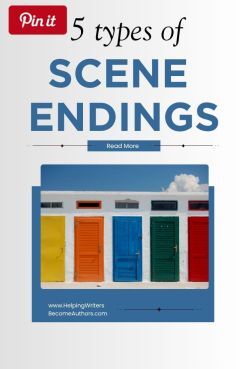 There’s nothing quite like a scene that ends with a bang—or at least a purposeful beat that pulls readers deeper into the story. A well-crafted scene ending doesn’t just wrap things up, it launches momentum into the next scene, tightens your pacing, and deepens the emotional arc. Your scene might close in any number of ways, everything from a victory to a setback or a plot twist to a moment of quiet revelation. Whatever the case, scene endings create the impression that will (hopefully) carry readers into what comes next. Really, your writer’s toolbox doesn’t contain many tools more powerful than scene endings, yet they can be easily overlooked when it comes to tightening tension or strengthening overall story structure.
There’s nothing quite like a scene that ends with a bang—or at least a purposeful beat that pulls readers deeper into the story. A well-crafted scene ending doesn’t just wrap things up, it launches momentum into the next scene, tightens your pacing, and deepens the emotional arc. Your scene might close in any number of ways, everything from a victory to a setback or a plot twist to a moment of quiet revelation. Whatever the case, scene endings create the impression that will (hopefully) carry readers into what comes next. Really, your writer’s toolbox doesn’t contain many tools more powerful than scene endings, yet they can be easily overlooked when it comes to tightening tension or strengthening overall story structure.
Classic scene structure breaks scenes into two broad halves: scene (action) and sequel (reaction). The scene half further breaks down into three primary pieces:
1. Goal (drives the action and intent of the scene as the character moves toward something).
2. Conflict (creates drama and complications by inserting obstacles that divert the smooth course of the character’s progression).
3. Outcome (shows the conclusion of the character’s efforts and reveals new complications leading to the next scene’s goal).
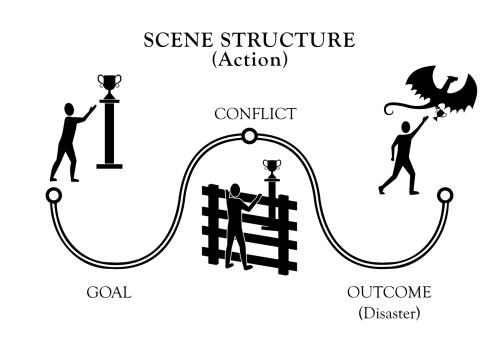
From the book Structuring Your Novel: Revised and Expanded 2nd Edition (Amazon affiliate link)
I have always emphasized the usefulness of two particular types of scene endings: the disaster (“no, and”) and the “yes, but” disaster. Today, I want to go deeper by breaking down five key types of scene endings—“Yes,” “Yes, But,” “No,” “No, And…,” and “No, But…”—and exploring how choosing the right one can keep your story flowing and your readers hooked.
In This Article:Why Ending Your Scenes Well Is Crucial for Pacing and TensionThe 5 Types of Scene Endings Writers Must Know (With Examples)“Yes” – Characters Get What They Want“No” – Characters Are Shut Down“Yes, But” — Small Victory With Complications“No, And…” – It Gets Worse, But There’s Hope“No, But…” – The Danger of False ProgressEnding Your Scenes With IntentionWhy Ending Your Scenes Well Is Crucial for Pacing and TensionFirst of all, let’s consider why we have scenes in our stories at all. Why not just one mad rush of action leading to the end? Although we could perhaps argue this a few different ways, the ultimate reason scenes are important in storytelling is the same reason any kind of structure is important: it creates and controls the pacing. And pacing, as I have shared before, is basically the writer’s version of the cool Jedi trick of mind control.
More than almost any other technique in fiction, pacing allows us to guide the audience’s experience. This is perhaps nowhere more true than of scene endings—which give audiences the opportunity to put the story down… or keep going. If you convince them to keep going, that means they’re enjoying themselves—and the more they’re enjoying themselves, the more likely they will stay all the way to the end.
Two Ways to Think About Scene EndingsThe outcome taking place at the end of the scene structure (discussed above).Any obvious break in the narrative—such as a chapter or commercial break or even just the subtle division of a scene break on the page.It’s important to notice that the two may be the same, but don’t have to be. A structural scene is defined by the pieces that make up its whole (scene and sequel, with all their smaller parts), while chapters and “scenes” (as dictated by visual scene breaks on the page) can be of whatever length is most useful to the pacing. A structural scene may expand across many chapters or a single chapter may contain multiple structural scenes.
>>Read more here: 7 Questions You Have About Scenes vs. Chapters
For our purposes today, we’re mostly focusing on the outcome of a structural scene. Why? Because these moments move beyond simple hooks or tricks used to tease audiences. Importantly, structural scene outcomes are always important turning points that advance the plot. The only way the plot is ever advanced is by something changing in the narrative—i.e., whatever scene goal the character just enacted cannot be enacted once again in exactly the same way. Something has changed. This could be simply that the character learned how to try again in a better way, or it could be that a major setback or achievement was reached that significantly altered the goal itself.
It’s also worthwhile to note that the idea of a scene “goal” does not necessarily insist that characters know exactly what they want and move toward it with single-minded focus. Sometimes the forward momentum implied by the idea of a “goal” is better recognized as simply an “intent” on the characters’ parts. They may be moving in a particular direction, but they may also (depending on the needs and tone of the story) simply be leaning in a certain direction.
Either way, what is most important is that this forward intent is met with some level of conflict. Here, too, it’s important to understand conflict in its broader sense. Conflict need not necessarily mean a confrontation or any hint of violence (i.e., something so slight as a disagreement on one end of the spectrum escalating into physical chaos on the other). Rather, conflict is best understood simply as something that impedes the scene’s forward momentum. Conflict is an obstacle creating the further complications or consequences that eventually change the character’s position within the narrative—thus changing the plot.
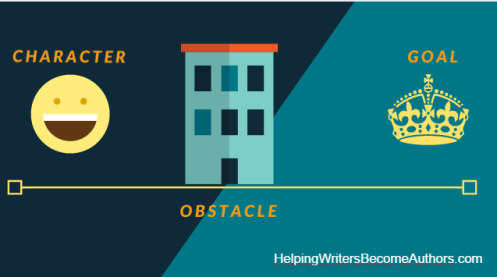
This change of situation is what then leads into the end of the scene—the outcome—which can show up as several different possibilities. Each possibility will impact your story’s pacing, flow, and function in different ways, which is why it’s important to understand all of them, the consequences they create, and which is best suited to any particular scene ending in your story.
The 5 Types of Scene Endings Writers Must Know (With Examples)So what are the best types of scene endings in fiction? Some endings slam the door shut. Others crack it open. Some fling it off its hinges and send your characters stumbling into the next chapter! What’s most important is that the scene’s outcome matters. It creates consequence, change, and momentum.
Let’s break down the five primary types of scene endings and explore how each one functions in your narrative (and why some are stronger choices than others).
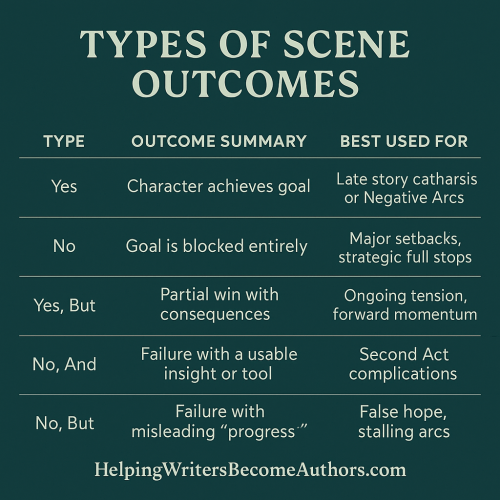
The five types of scene endings are “Yes,” “No,” “Yes, But,” “No, And,” and “No, But.”
1. “Yes” Scene Ending — Characters Get What They WantThis one’s straightforward: characters set out to achieve a goal in the scene, and they succeed. (Yay!) Sometimes “yes” endings can be deeply satisfying. However, they must be used with caution and awareness as they risk deflating tension. Usually, ultimate success is reserved only for the end of the story. This is for the simple reason that once the character has definitively succeeded (or failed) to reach the overall story goal, the plot is over. If your characters’ progress toward that ultimate goal is left unimpeded for too long, the plot will quickly run its course.
Of perhaps even greater concern is that “yes” scene endings don’t always generate new questions or consequences for the characters to explore in subsequent scenes. Usually, “yes” scene endings are most appropriate later in the plot when you’re wanting to show characters getting closer to achieving their final success. “Yes” scene endings can also be used for catharsis late in the story to relieve some of the tension you may have built—such as when romantic couples finally get together in a positive and love-affirming way (even if their struggles in the main plot haven’t yet been fully resolved).
Ironically, “yes” scene endings can be more appropriate in Negative Change Arc stories than in Positive Change Arc stories. This is because when a character is headed for a bad end, the successes achieved on the scene level ultimately lead to greater accumulated consequences down the line.
For Example:
In The Great Gatsby, when Gatsby finally reunites with Daisy at Nick’s house, he achieves his goal of finally meeting with her. The scene ends with Gatsby glowing in his long-awaited triumph. No real conflict derails the scene goal, and Gatsby doesn’t have to pay any immediate price. He gets exactly what he wants, and in that moment, it feels like success.

The Great Gatsby (2013), Warner Bros.
2. “No” Scene Ending — Characters Are Shut DownBy contrast, in a “no” ending, characters are stopped cold. The movement toward the goal isn’t just complicated, it’s outright blocked. No progress whatsoever is made. “No” scene endings can be effective for shooting the stakes sky-high. However, they should also be used with caution. Too many in a row means the plot can make no progress since characters never get any closer to the overall story goal. More than that, the absoluteness of “no” endings can make it difficult for characters to regroup or gather enough context to try again in a different way.
“No” endings often bring the narrative to a screeching halt. This is rarely a good plot device, since it actually kills tension instead of building it. In essence, if a “yes” ending deflates conflict by giving the protagonist a win, the “no” ending kills the conflict by instead giving the antagonistic force the win. There aren’t a lot of options for the protagonist after a solid “no” ending.
One of the only times a hard “no” ending might be desirable is when you do, in fact, want to screech the plot to a halt for a bit, as would be the case if you wanted to return to deeply traumatized or disillusioned characters after a passage of time in order to watch as they pick themselves back up.
For Example:
The Empire Strikes Back ends with a pivotal “no” when Luke Skywalker confronts Darth Vader in Cloud City. Luke’s goal is clear: defeat Vader and save his friends. Not only does he fail to defeat Vader, he loses his hand and is hit with the devastating reveal that Vader is his father. Physically, emotionally, and psychologically, he is stopped cold. The scene doesn’t just complicate things, it shuts the door completely. He escapes only by falling into the void. And after this moment, the plot does screech to a halt for a time between episodes, which allows the necessary space for Luke to reflect, regroup, and build into a new approach in Return of the Jedi.

Star Wars: The Empire Strikes Back (1980), 20th Century Fox.
3. “Yes, But” Scene Ending — Small Victory With ComplicationsOne of the most useful scene endings is the “yes, but” outcome. This one mixes elements of victory and defeat to deepen the narrative. On the one hand, the characters’ efforts achieve a “yes”—they get some or all of what they wanted in the scene. On the other hand, they are met with a “but”—their gain comes with complications or consequences.
This approach is particularly effective since it allows the plot to move steadily forward thanks to the characters’ achievement of scene goals on the path toward the larger story resolution. It also ensures the plot can’t end too quickly, thanks to the complications that prevent a clean victory. For instance, perhaps the characters get half of what they want, but that means they also don’t get half of what they want. Or perhaps they get exactly what they sought in this scene, but doing so raises the stakes or gets them into trouble, which can then prompt a new goal in the next scene.
From a pacing perspective, the “yes, but” scene ending is great since it gives the audience little hits of satisfaction as the characters receive yummy rewards, but it also ramps tension and keeps readers reading since these rewards complicate either the characters’ lives or their forward progress toward the ultimate catharsis of the Climactic Moment. In truth, this type of scene ending is so useful and versatile, you could easily use it for every scene outcome all the way to the end.
For Example:
The Fellowship of the Ring offers a great “yes, but” during the Council of Elrond when Frodo volunteers to take the Ring to Mordor. Although Frodo’s goal in that moment isn’t fully conscious, his intent is clear: he wants to do the right thing, stop the Council’s squabbling, and take responsibility for the burden he’s been given. He succeeds when the Council accepts his offer in a definitive “yes.” The complications, however, are enormous as this decision definitively turns the plot by launching Frodo onto a long, dangerous road filled with escalating threats.
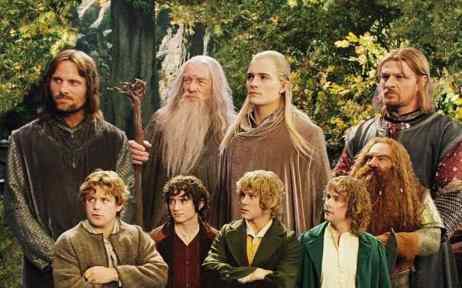
The Lord of the Rings: The Fellowship of the Ring (2001), New Line Cinema.
4. “No, And…” Scene Ending — It Gets Worse, But There’s HopeWhat’s the difference between a “yes, but” and a “no, and” scene ending? The “no, and” scene ending is similar to the “yes, but” ending, but flips the script. Here, instead of mostly succeeding, characters mostly fail. However, the failure is not complete. Out of the rubble of failure, scraps of insight or hope emerge. Some small bit of ground is gained.
The “no, and” scene ending is the classic “cup half full.” Everything’s gone to pot, yet characters are still able to salvage some small win. They find a way forward through the mess or latch onto the bit of knowledge learned from their mistakes. Whatever the case, the most important thing to leverage about a “no, and” ending is that it moves the plot. The only way it can do that is by changing something for the characters. Even though they may have spectacularly failed to gain what they wanted, they now have some tool or clue that allows them to try again but in a different way.
“No, and” endings can’t be used as exclusively as “yes, but” endings (unless your story leads to your characters’ ultimate failure), but they can be used liberally, especially in the Second Act, to increase tension, raise the stakes, and create interesting dynamics for prompting characters to evolve.
For Example:
The Martian by Andy Weir features a great “no, and” scene ending when protagonist Mark Watney tries to make water to grow his crops and accidentally blows himself up. His goal was simple: create a livable environment using chemistry and ingenuity. The scene ends in failure. However, in the aftermath, he figures out what went wrong, recalibrates his approach, and gains critical information about how to proceed more safely next time.

The Martian (2015), 20th Century Fox.
5. “No, But…” Scene Ending — The Danger of False ProgressThis is the trickiest one. In a “no, but” ending, characters fail to get what they want, but walk away with something that seems helpful—until it turns out it’s not. “No, but” scene endings creates the illusion of movement without true momentum. As a plot device, this is never particularly useful since it never actually moves the plot, no matter how much it may look like it does. It creates dead ends in which characters spend time working on a seeming solution—only to end up exactly where they started back before the original “no, but” scene. The result can be a “busy” plot that actually goes nowhere.
The “no, but” outcome may be used very occasionally with purposeful effect to emphasize a character’s current refusal to learn and/or to face consequences or personal blind spots. It can also be used to deepen tension and despair in certain situations, in which a character is clinging to false hope—such as in disaster stories in which characters think they have found a way out of their peril only to realize it was a mirage. Used sparingly, this kind of scene can underscore a character’s stuckness or false sense of growth.
For Example:
Indiana Jones and the Last Crusade features a solid “no, but” scene early on when Indy fails to recover the Cross of Coronado from the treasure hunter who stole it. He’s given a token “win” when the local authorities thank him and the museum director tells him, “At least you tried.” However, although it may feel like he’s accomplished something or at least clarified his purpose, the artifact is still gone. He’s no closer to recovering it than he was before. This isn’t progress. The “but” gives the illusion of development, but the narrative is effectively paused until the real plot kicks in with the Grail storyline.

Indiana Jones and the Last Crusade (1989), Paramount Pictures.
Ending Your Scenes With IntentionAs with most writing techniques, the power of scene endings lies not simply in recognizing the options, but in knowing how and when to use them. The way you close a scene determines how your story moves forward. This is true whether you’re building tension, paying off a moment of catharsis, or giving your characters one more reason to grit their teeth and keep going. If your scene endings feel flat, confusing, or disconnected, chances are your plot is suffering too. However, when you choose your outcomes with intention by aligning them with character goals, story structure, and pacing, you can create a reading experience that feels cohesive and alive with momentum.
In SummaryScene endings are structural turning points that determine your story’s pacing, tension, and sense of movement. Choosing the right type of outcome, whether it’s a clean win, a total failure, or something sneakier in between, can keep your plot evolving and your readers fully engaged.
Key TakeawaysEvery structural scene ends with an outcome that determines the story’s forward momentum.The five main types of scene endings are: “Yes,” “No,” “Yes, But,” “No, And,” and “No, But.”“Yes” scene endings create character success but can flatten tension if overused.“No” scene endings end in total failure and must be used sparingly to avoid stalling the plot.“Yes, But” scene endings are the most versatile, combining satisfaction with escalating tension.“No, And” scene endings emphasize failure but give characters new tools or insight to try again.“No, But” scene endings create only the illusion of progress and should be used sparingly to avoid plot dead ends.Want More?
Structuring Your Novel: Revised and Expanded 2nd Edition (Amazon affiliate link)
If you’re ready to take a deep dive into the mechanics of scene structure, including how to seamlessly integrate your scene and sequel halves, check out my book Structuring Your Novel. Not only will it teach you how to structure a solid plot, it’s packed with practical tools and intuitive frameworks to help you build scenes that keep readers reading. It’s available in e-book, paperback, and audiobook.
Wordplayers, tell me your opinions! Which of these five scene endings do you find yourself using most often? Are there any you tend to avoid? Tell me in the comments!Click the “Play” button to Listen to Audio Version (or subscribe to the Helping Writers Become Authors podcast in Apple Podcast, Amazon Music, or Spotify).
___
Love Helping Writers Become Authors? You can now become a patron. (Huge thanks to those of you who are already part of my Patreon family!)The post The 5 Types of Scene Endings Every Writer Must Master appeared first on Helping Writers Become Authors.

